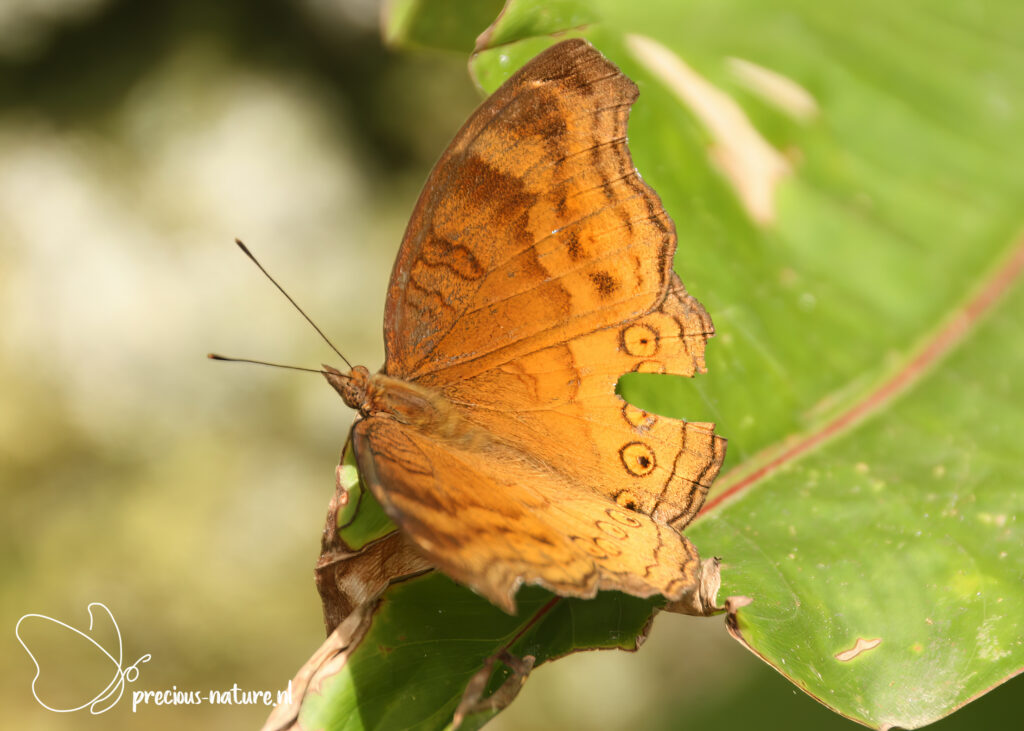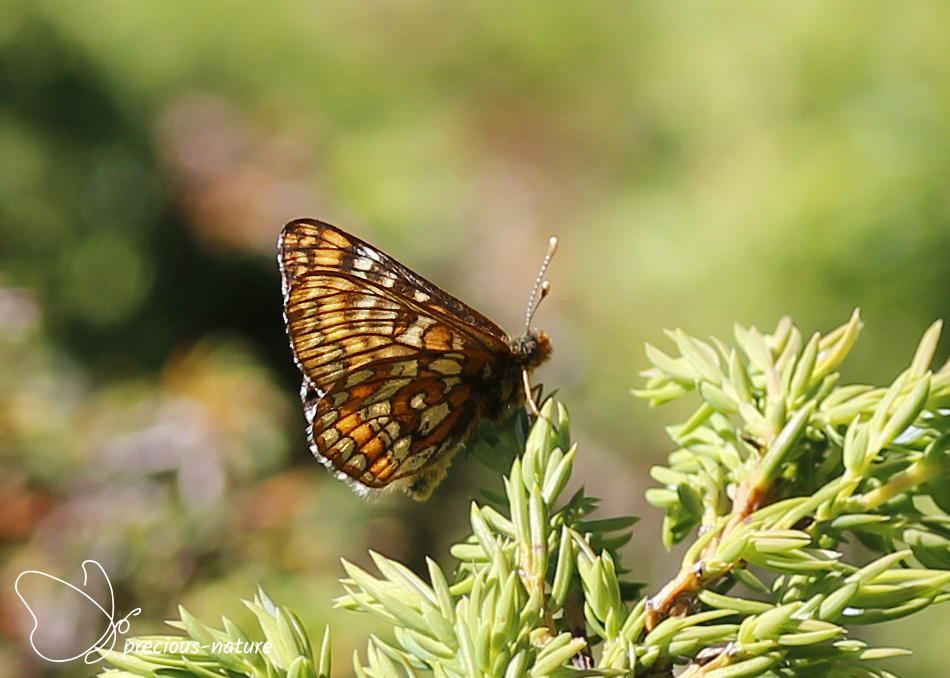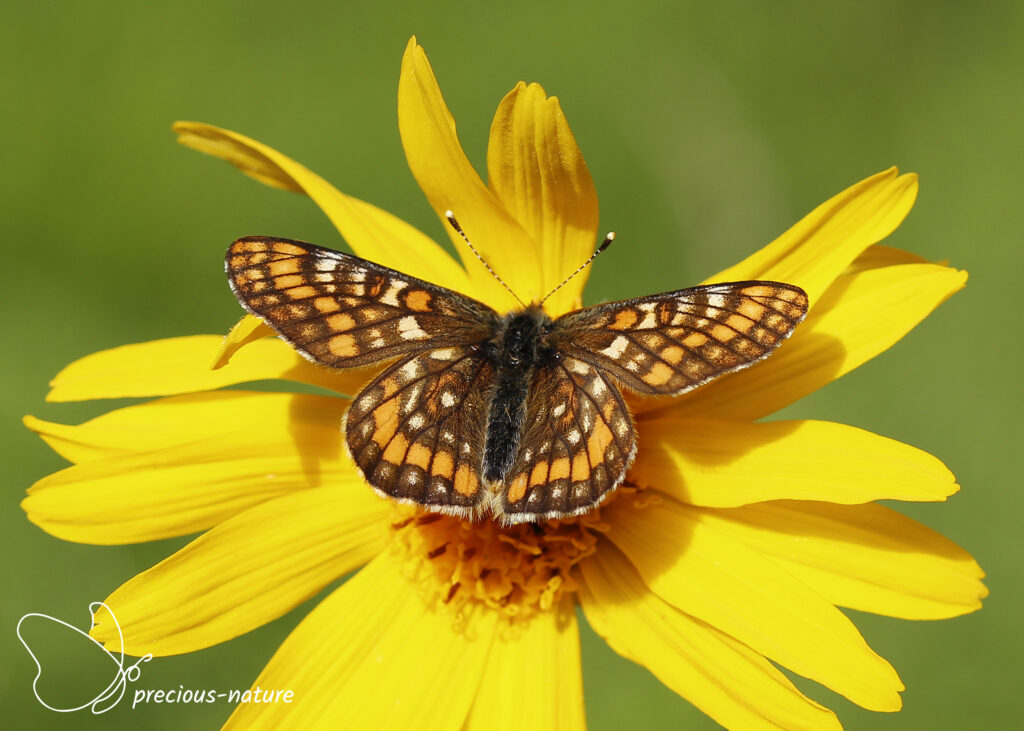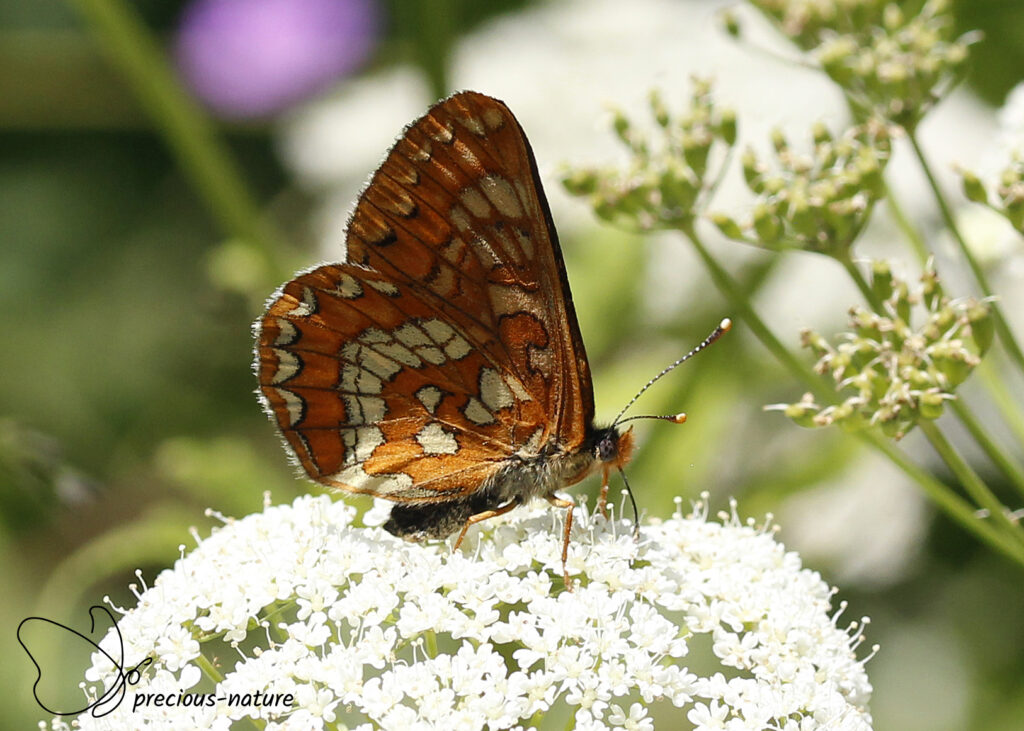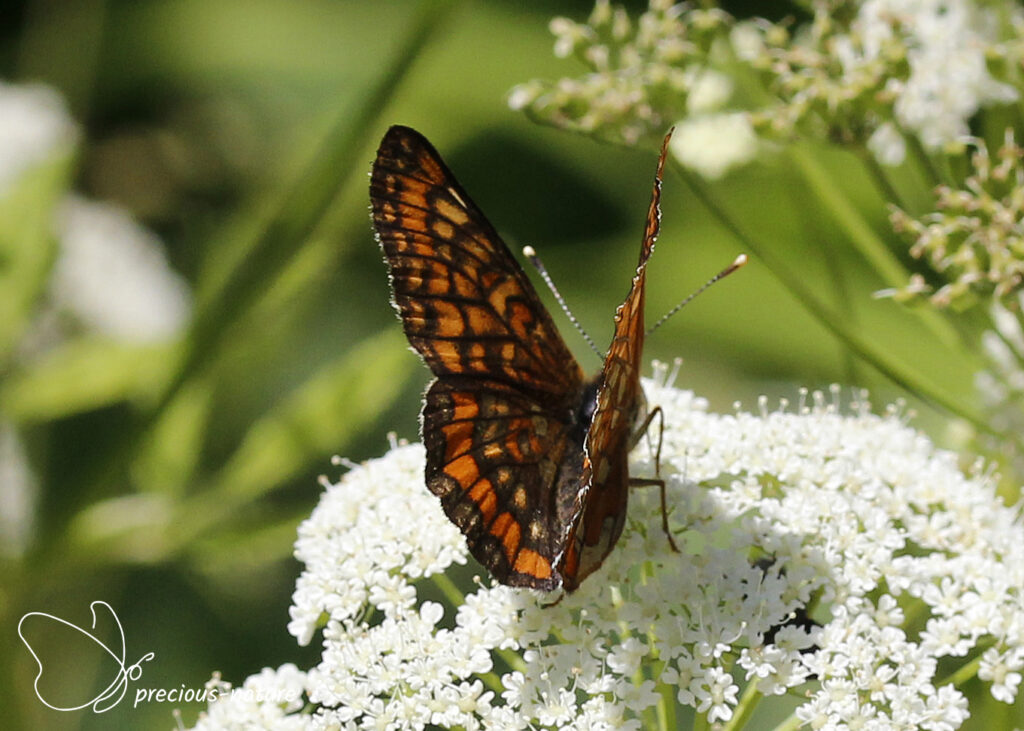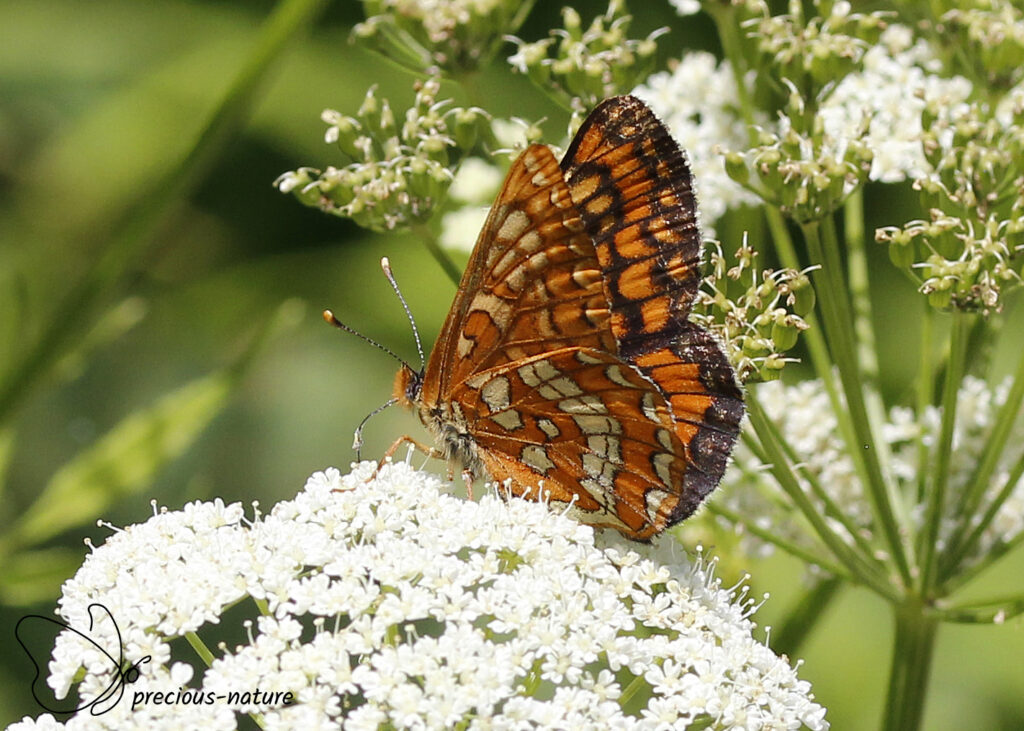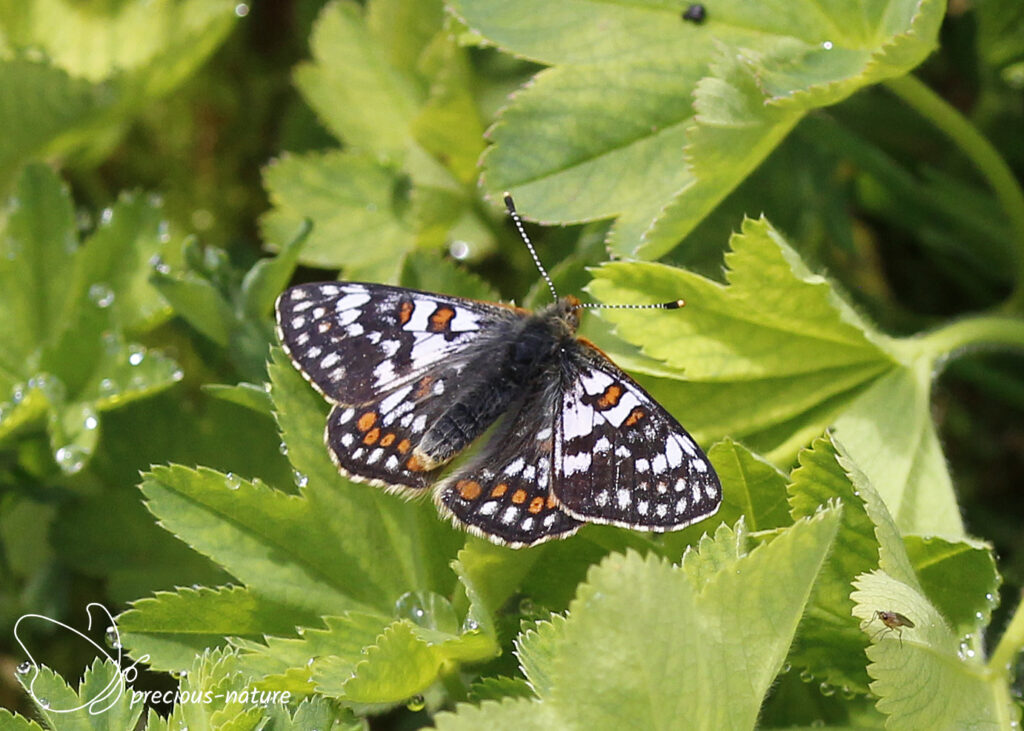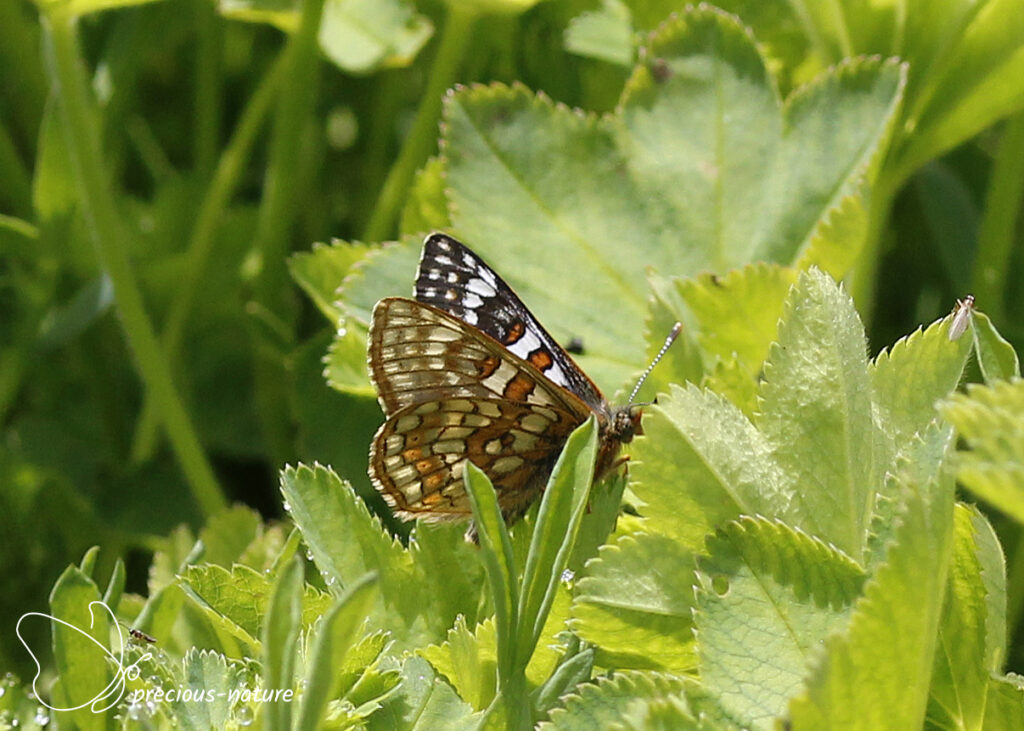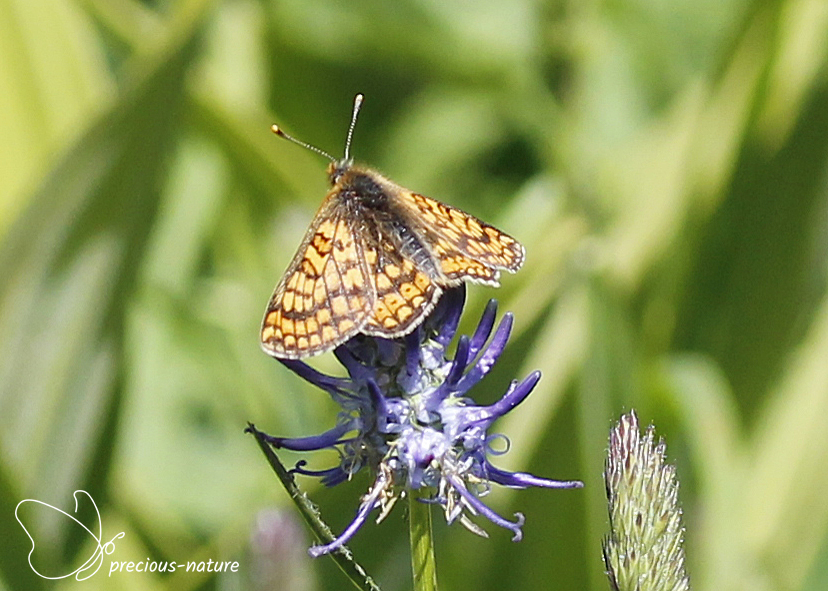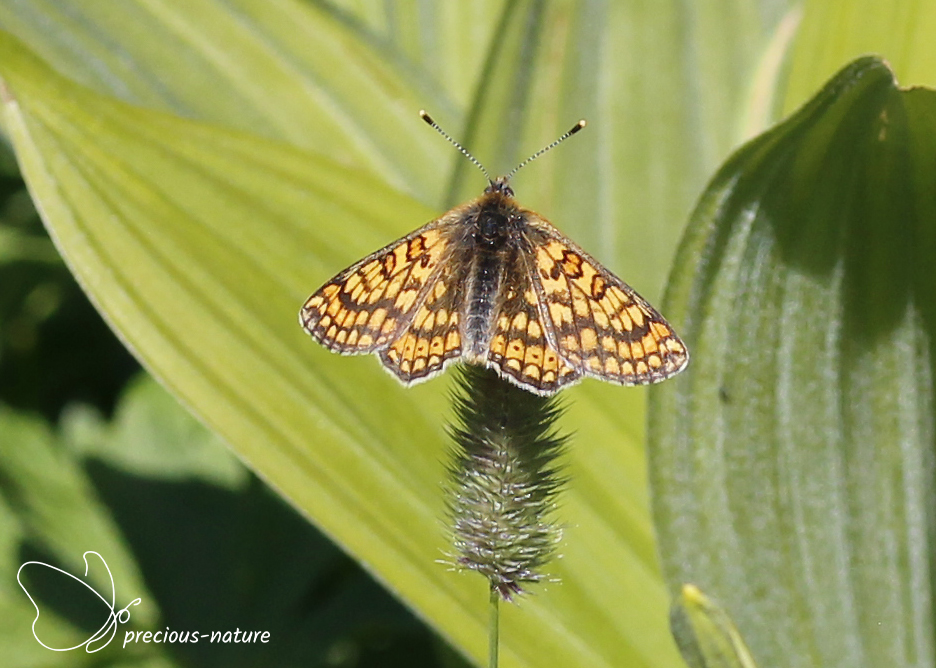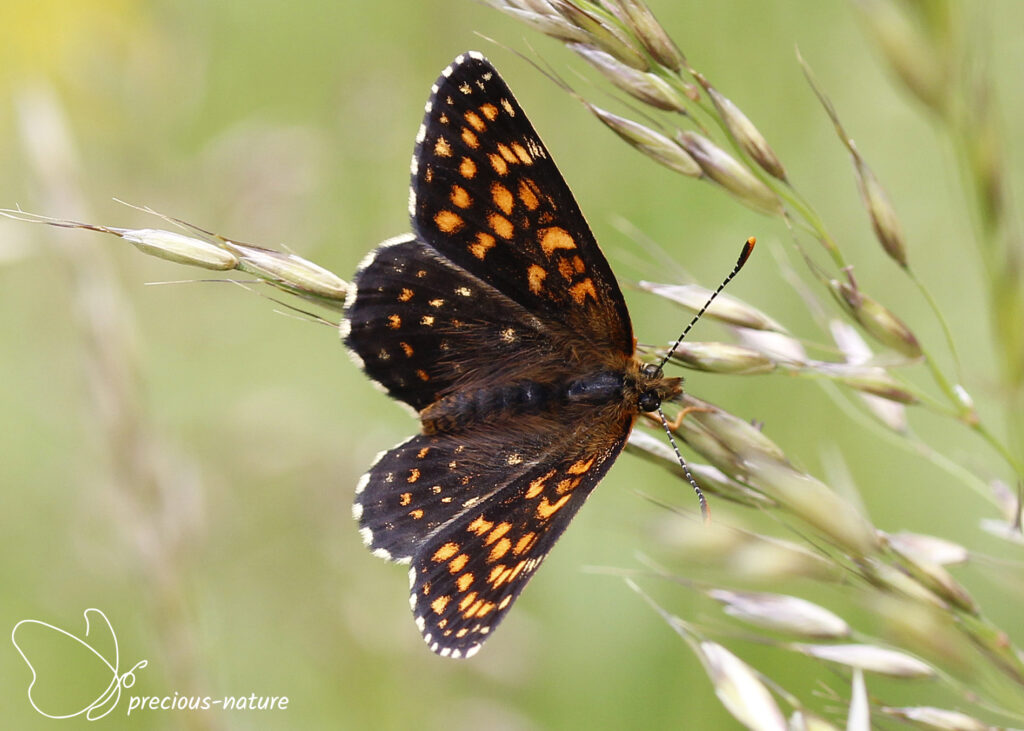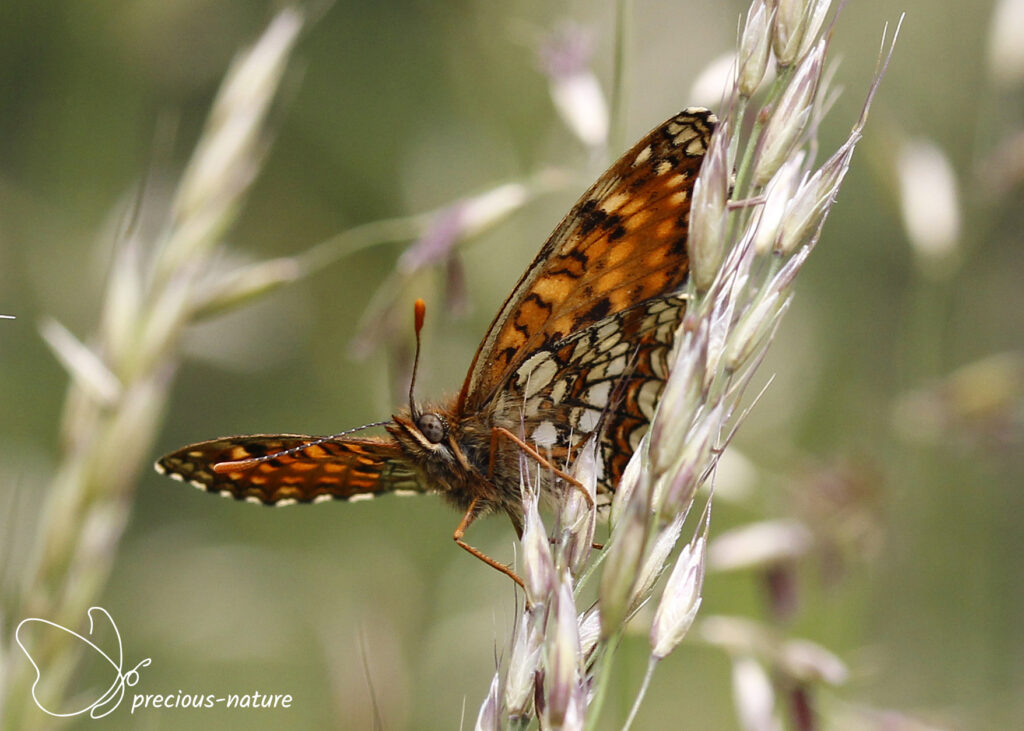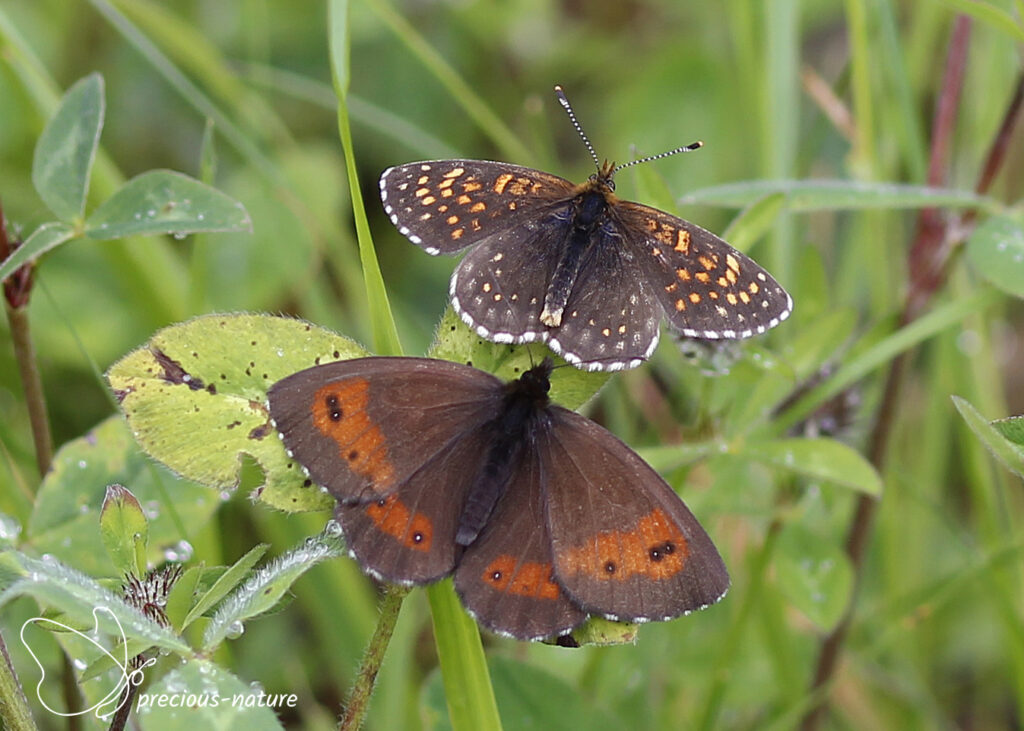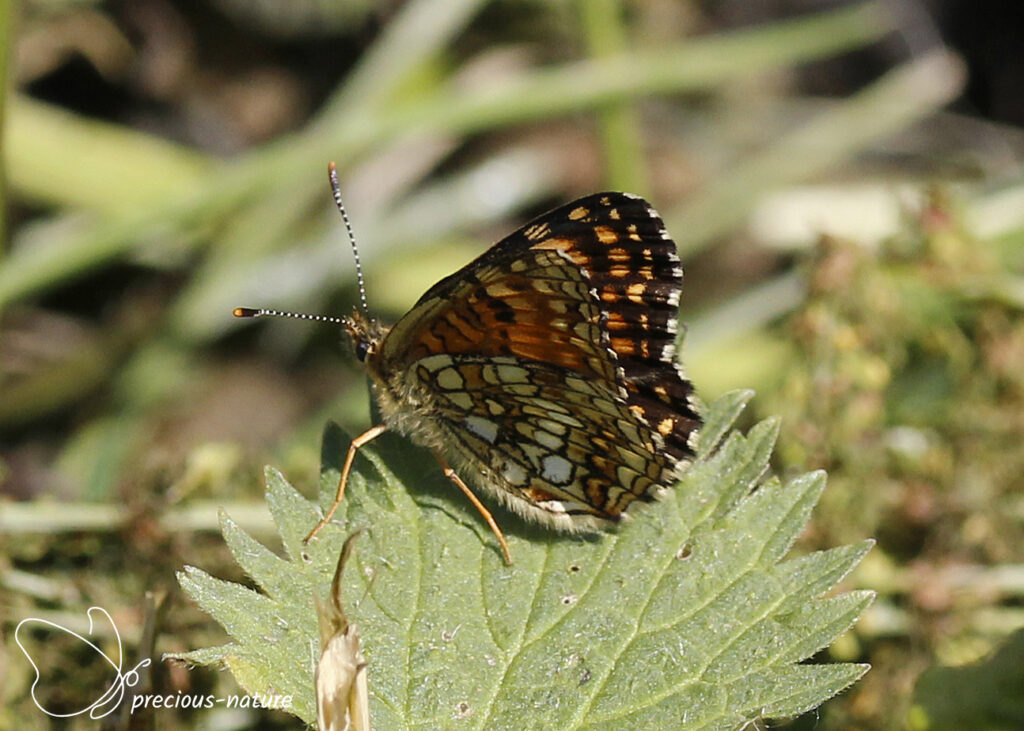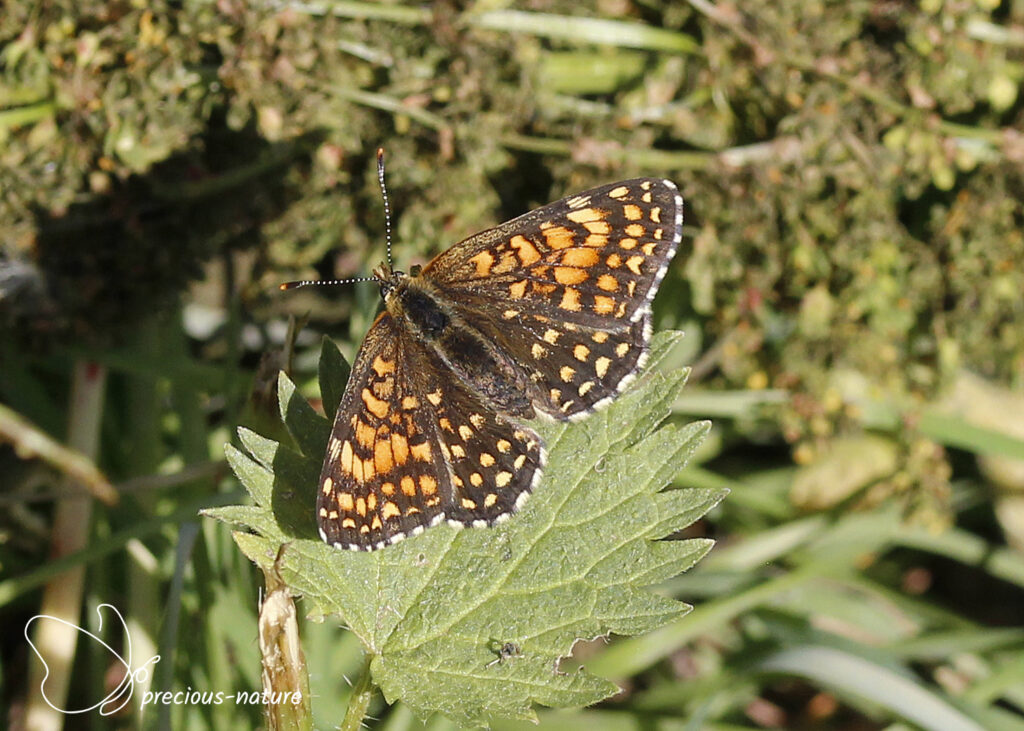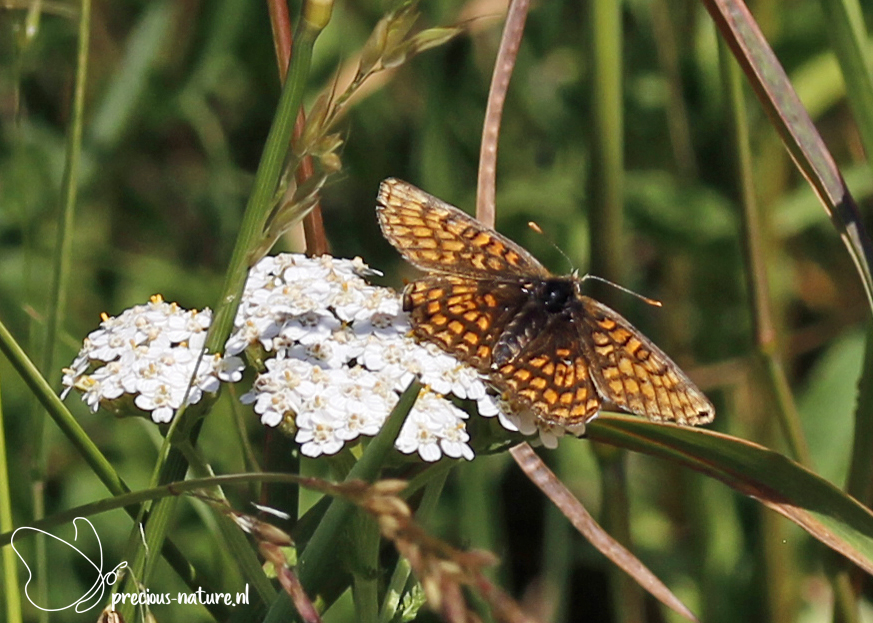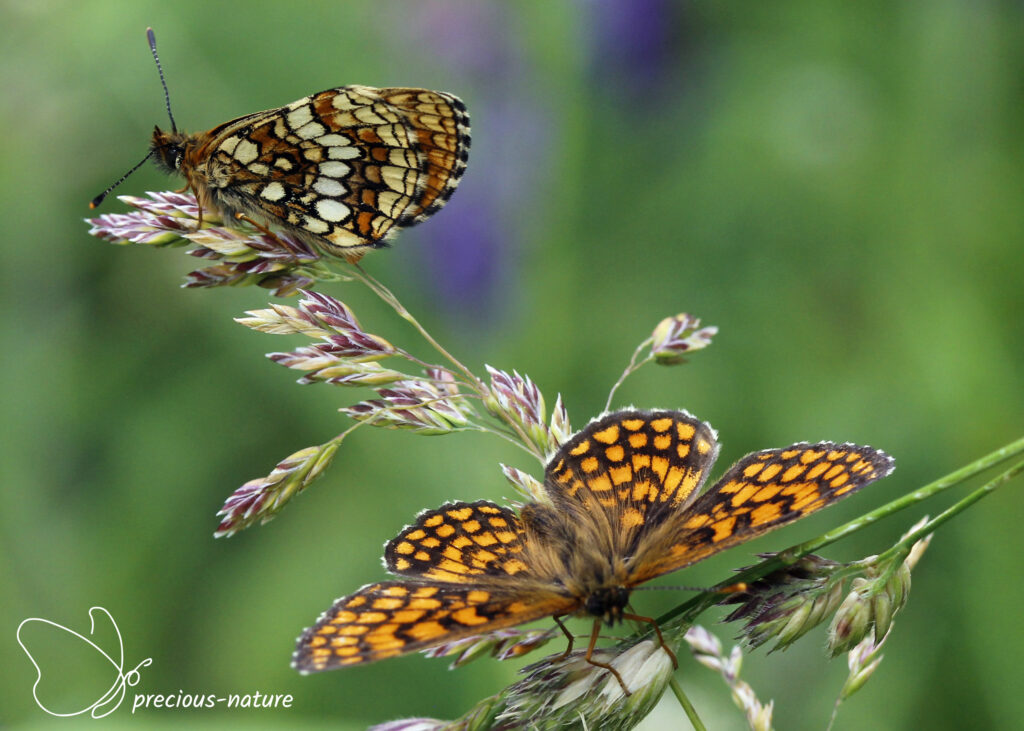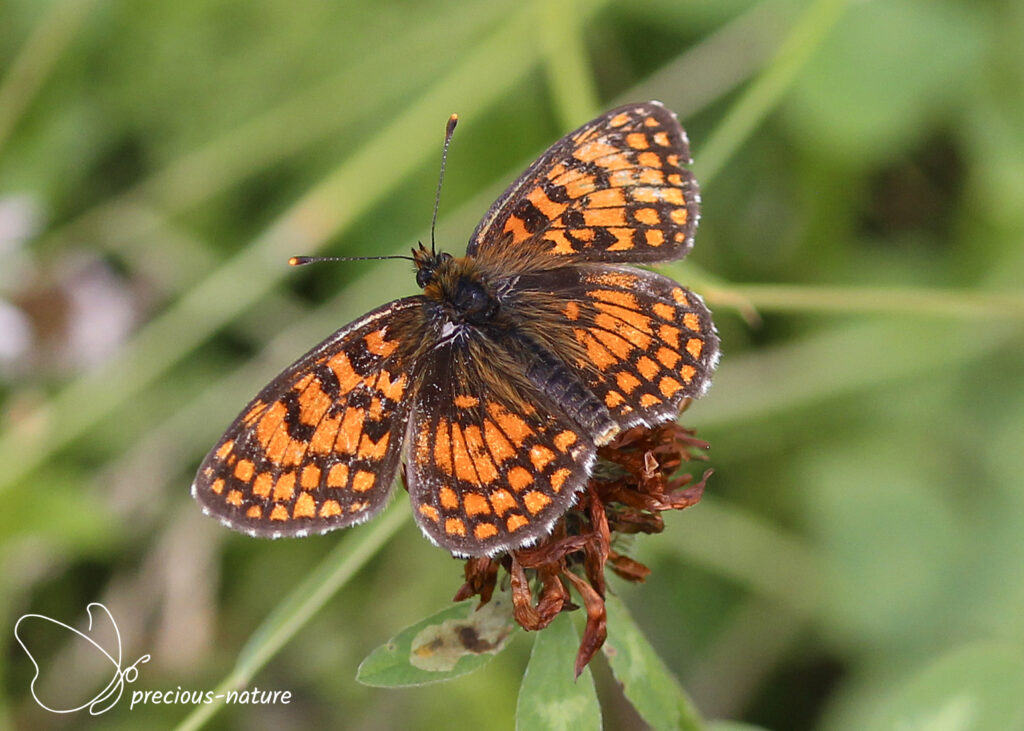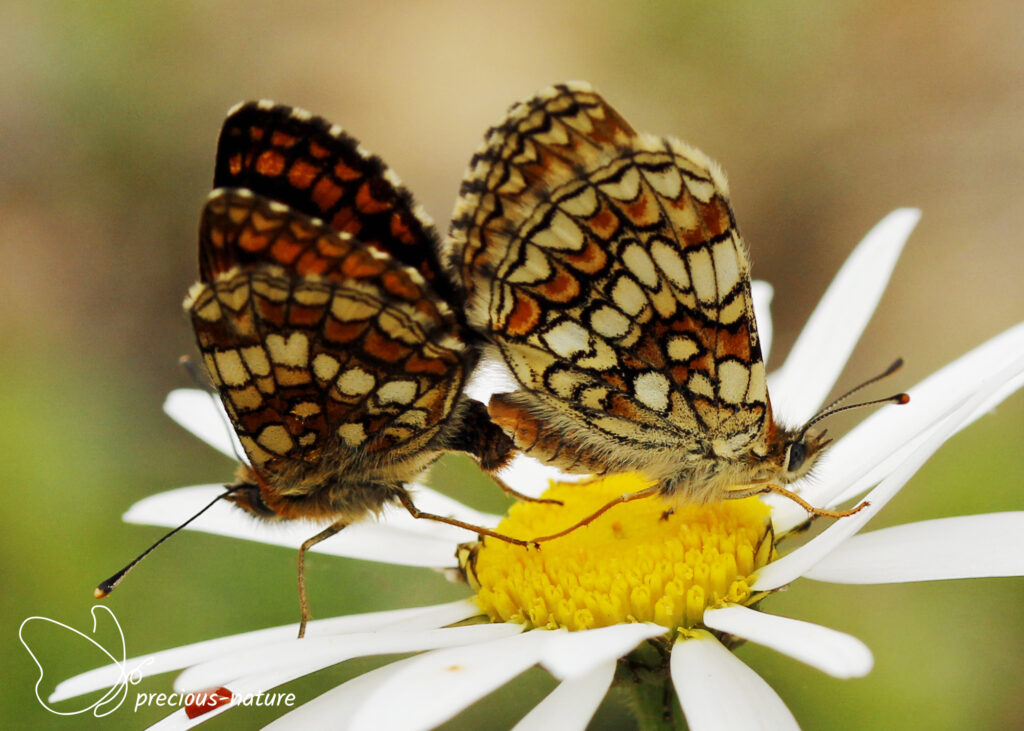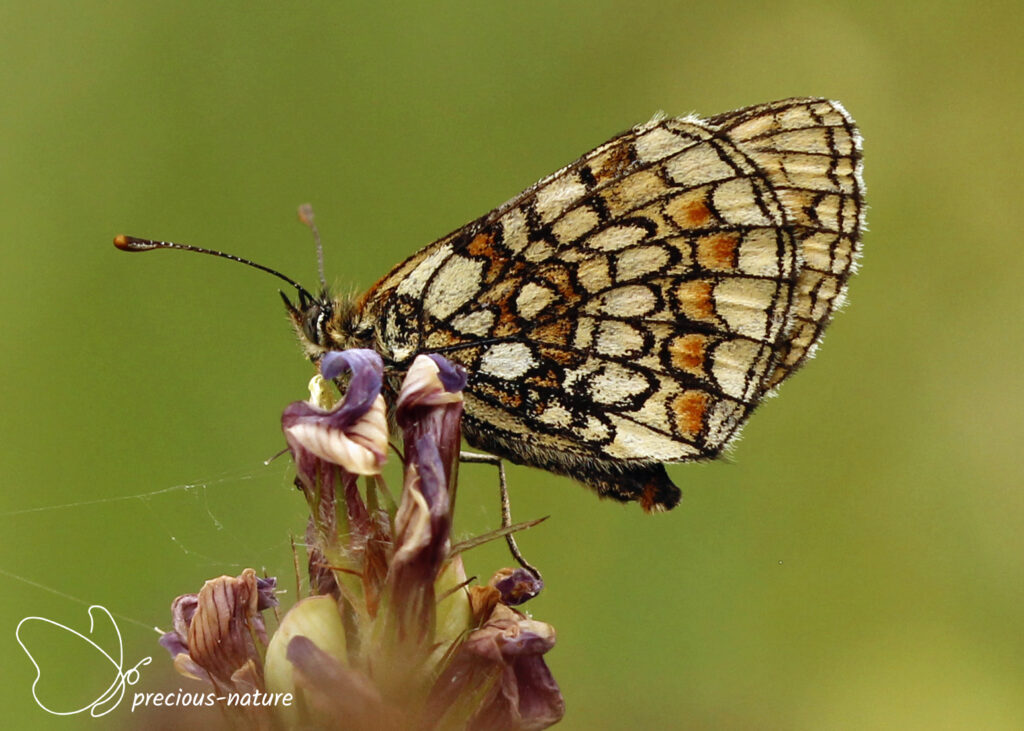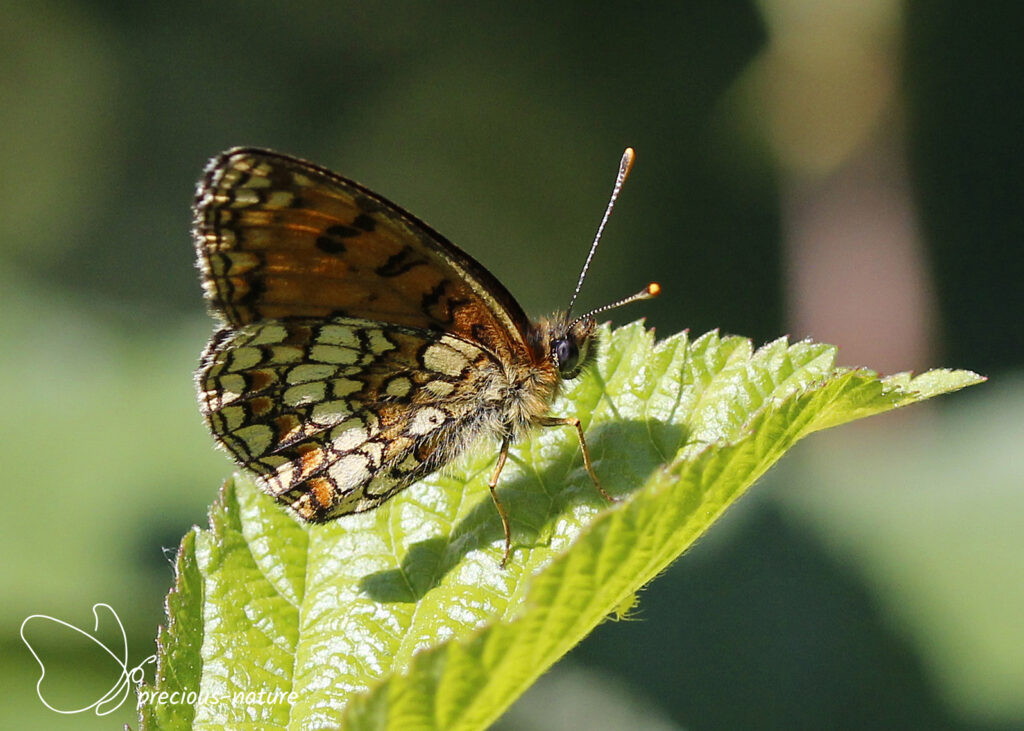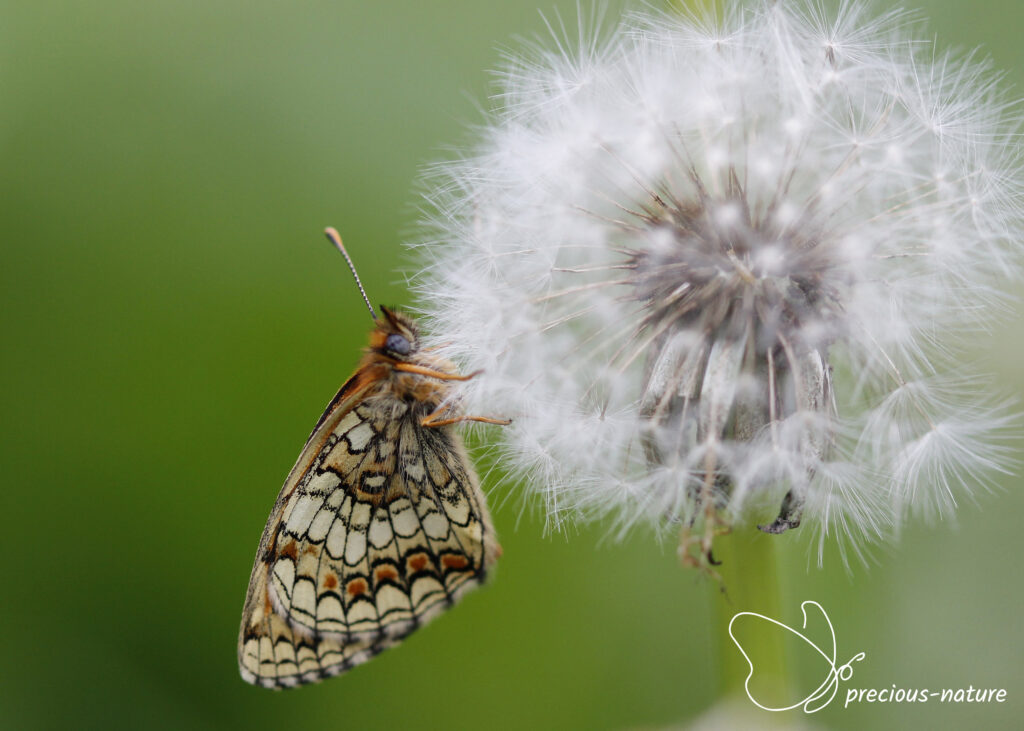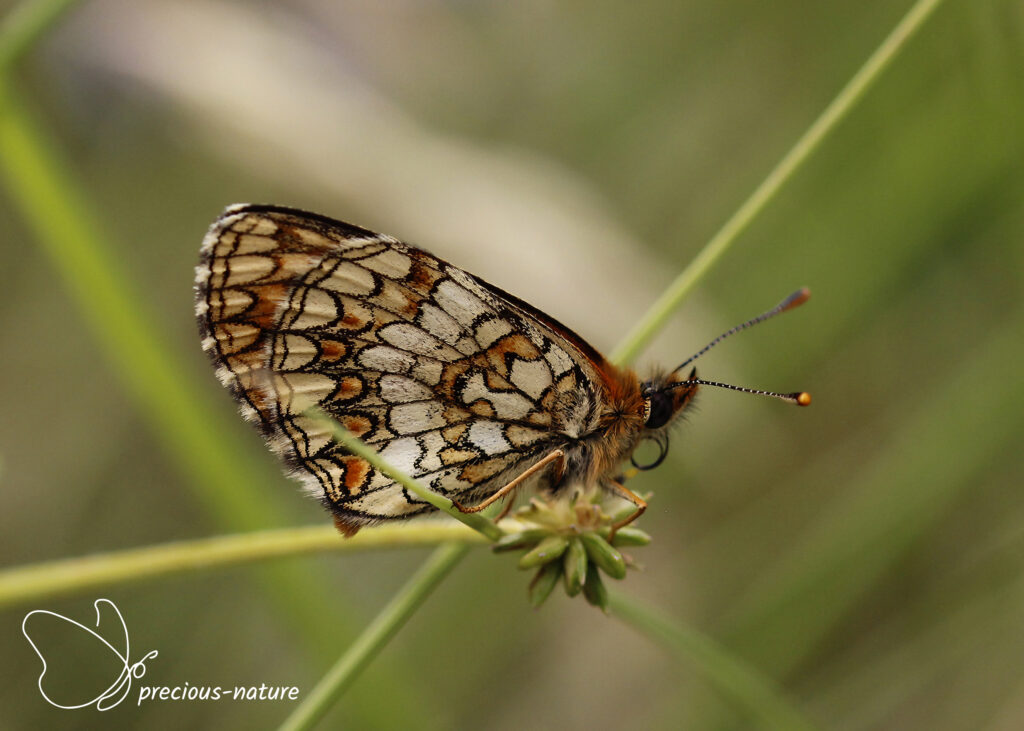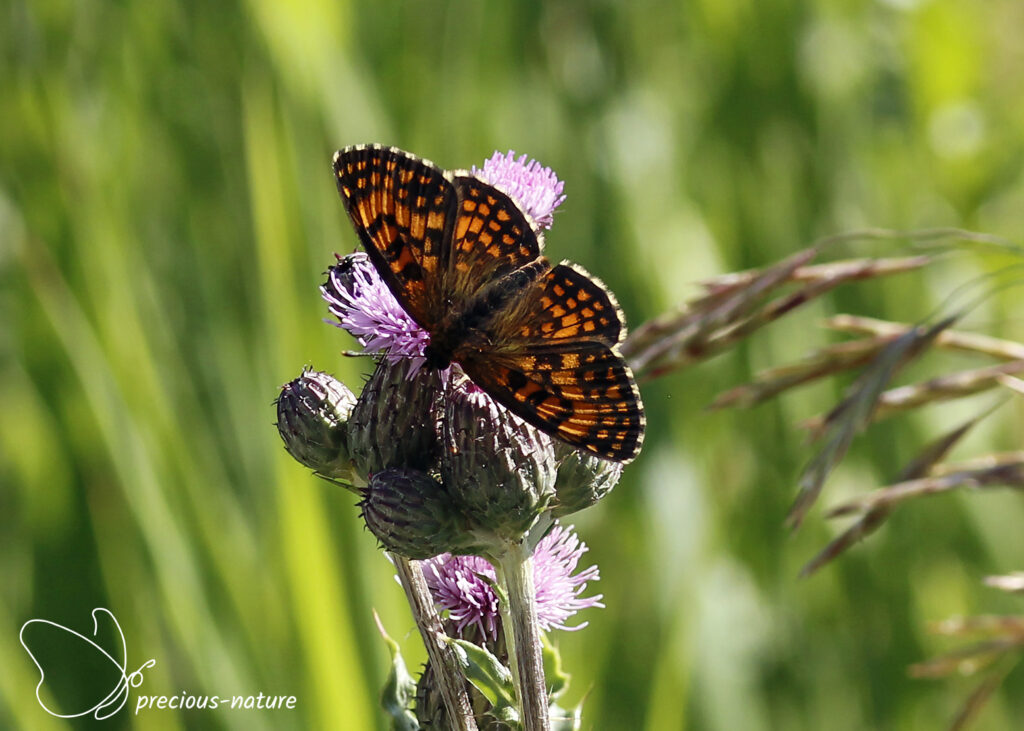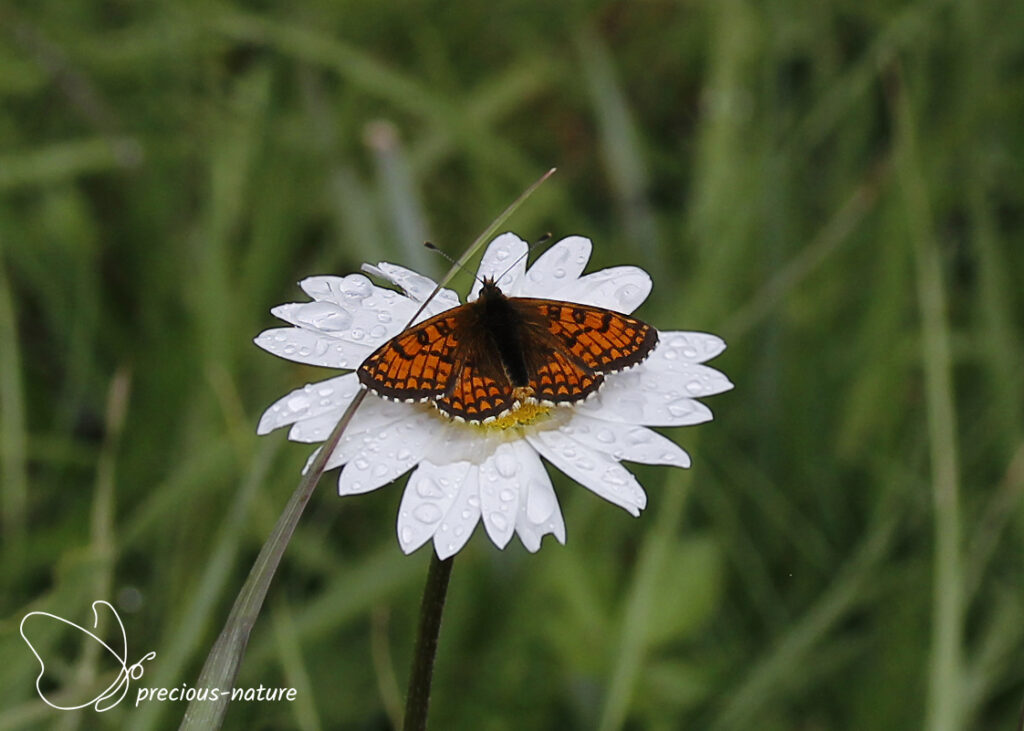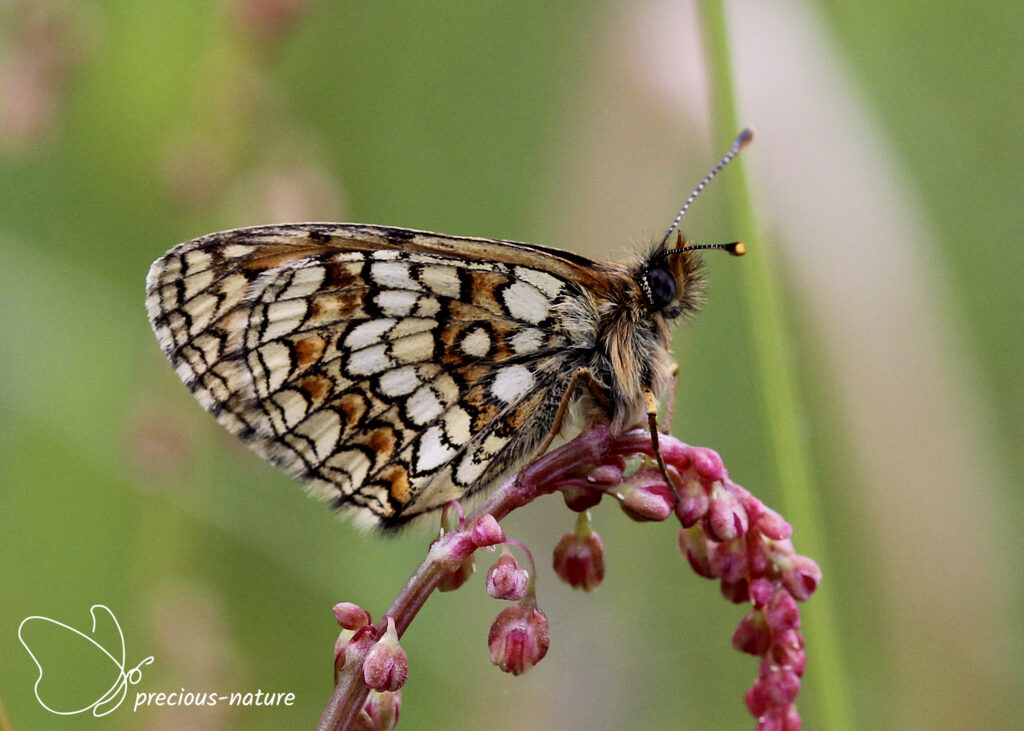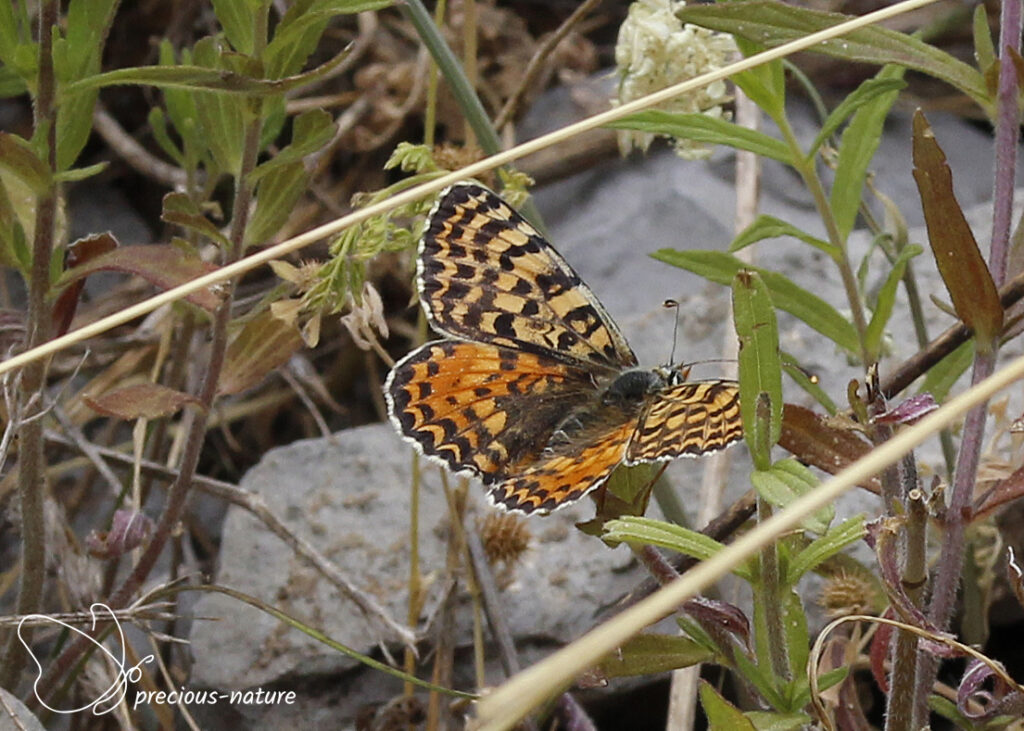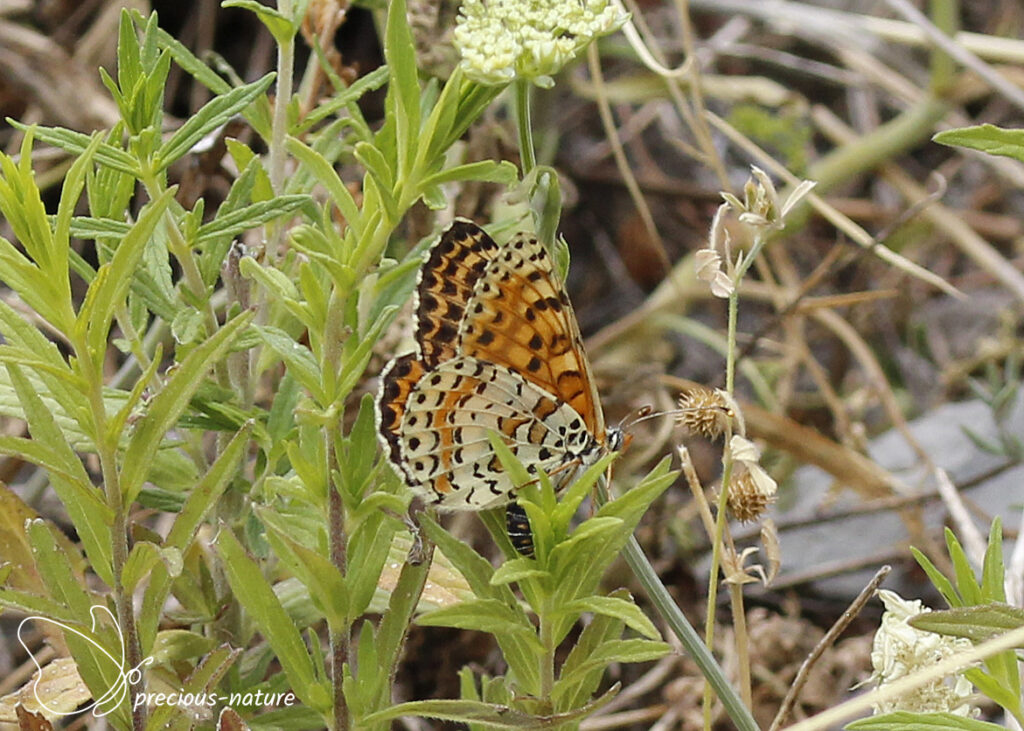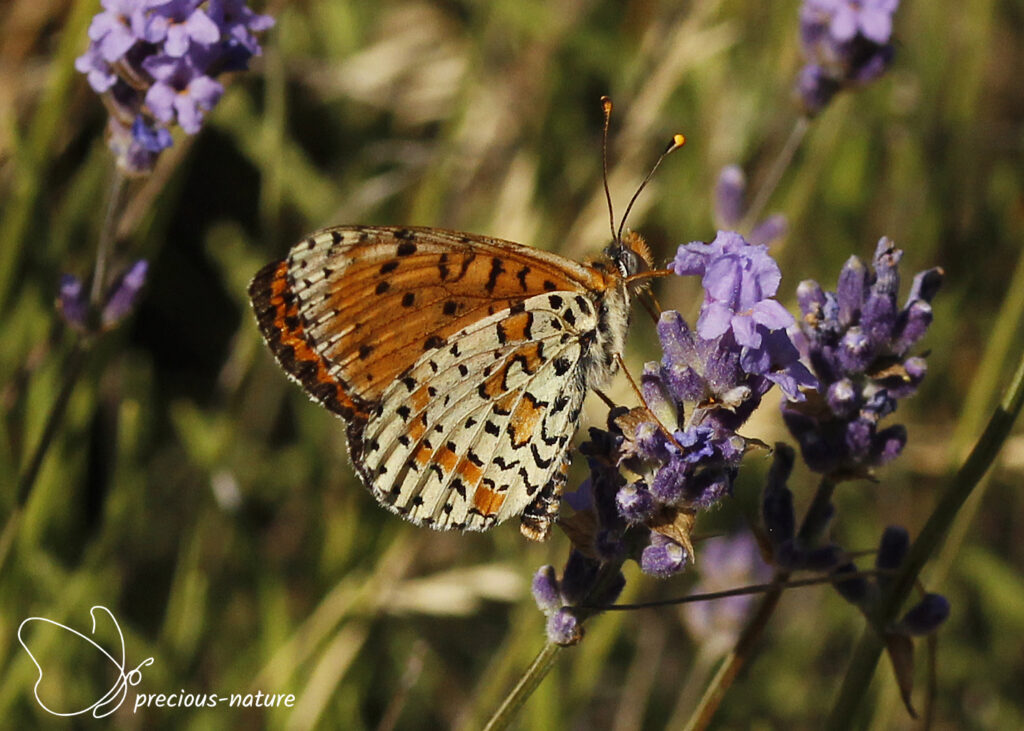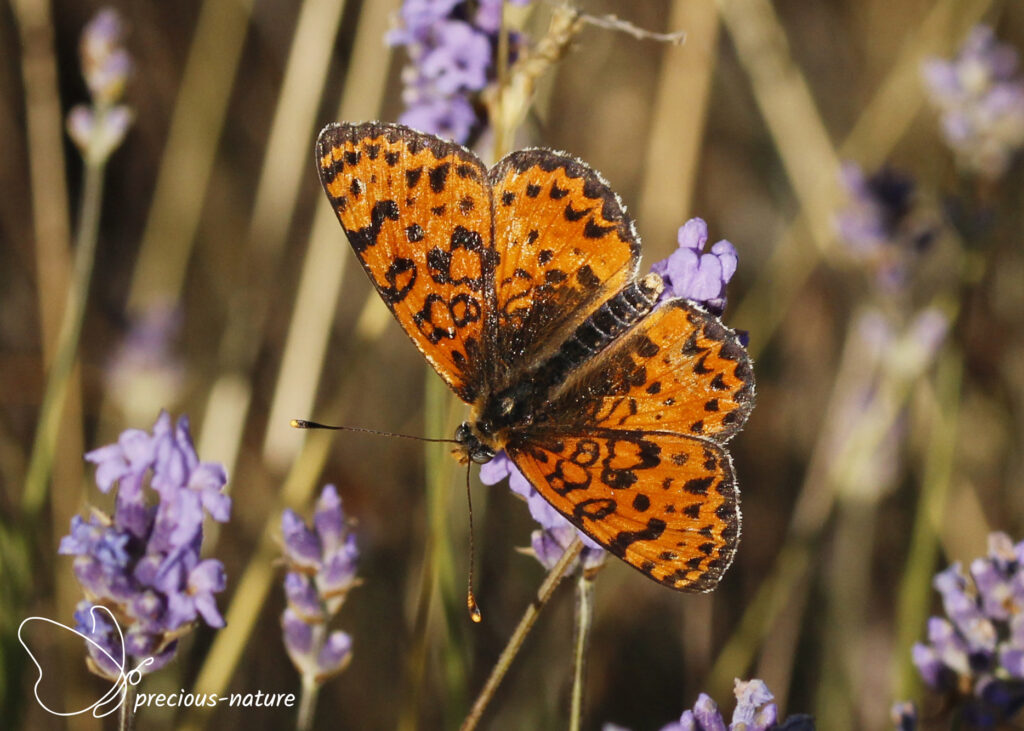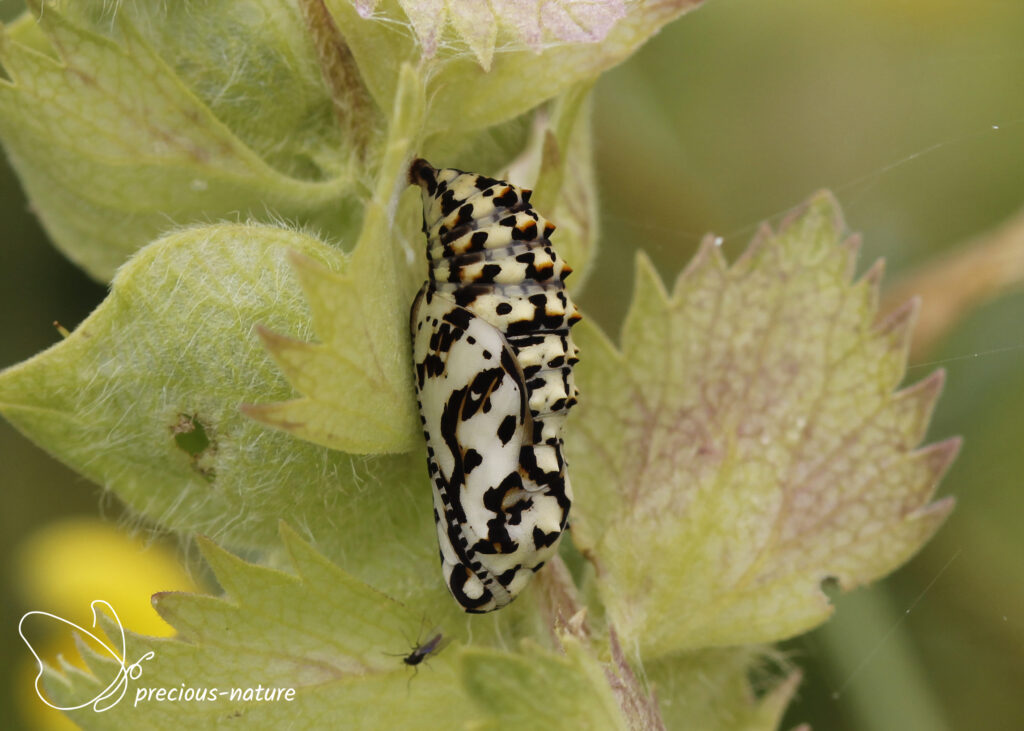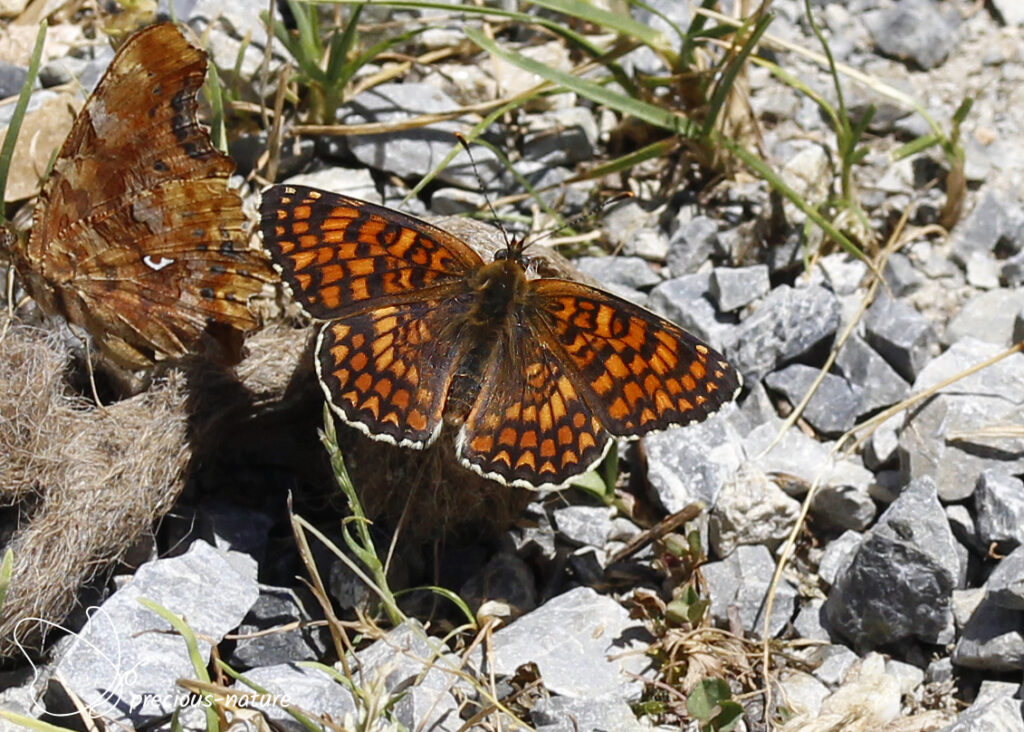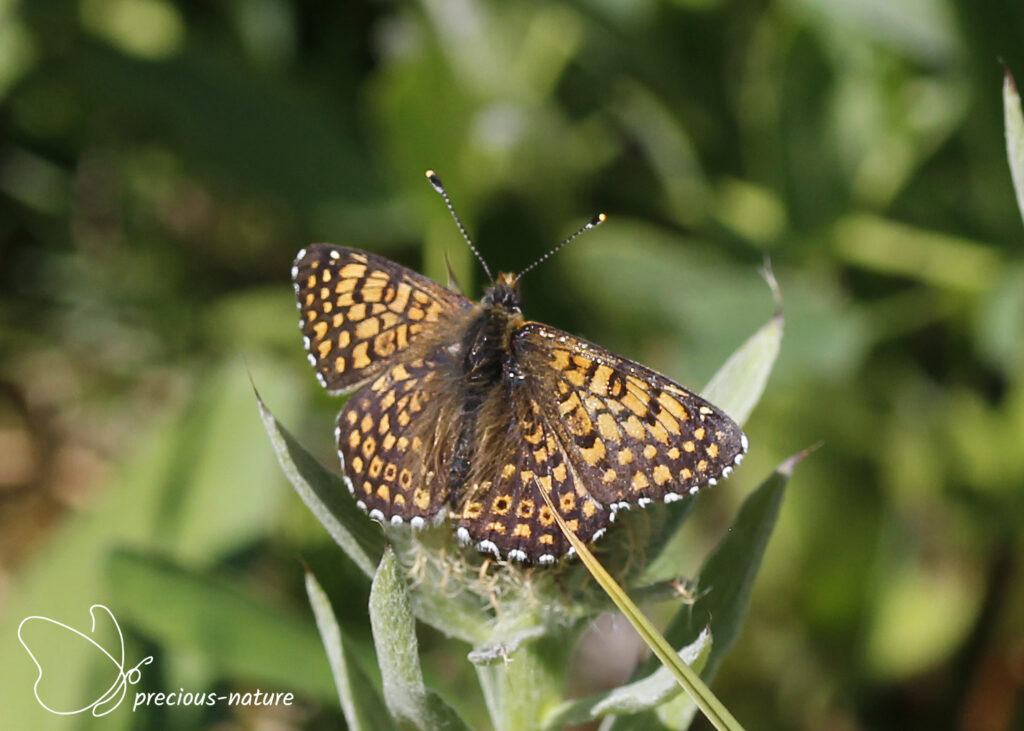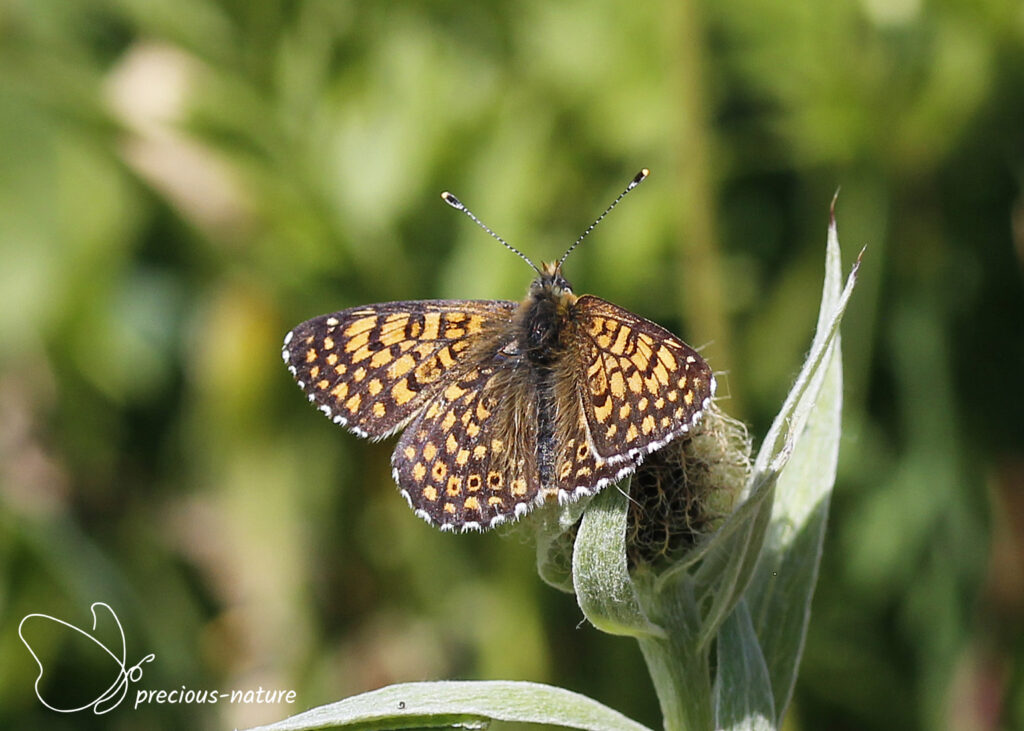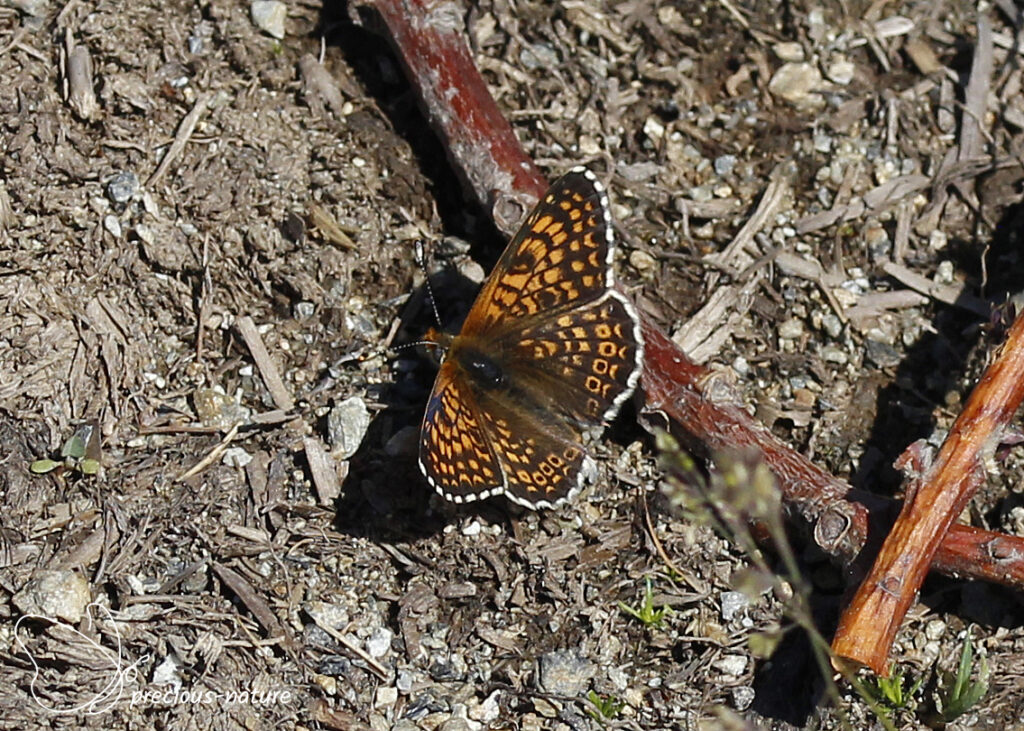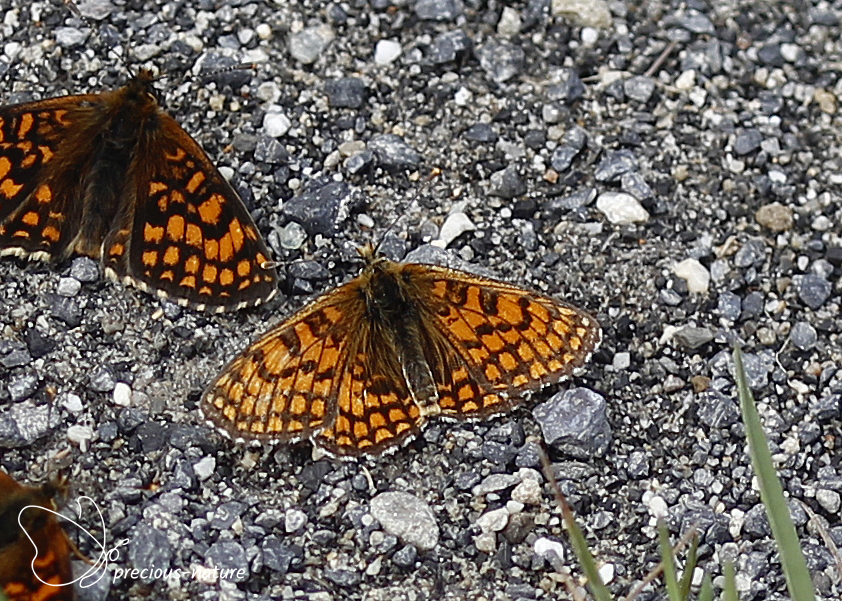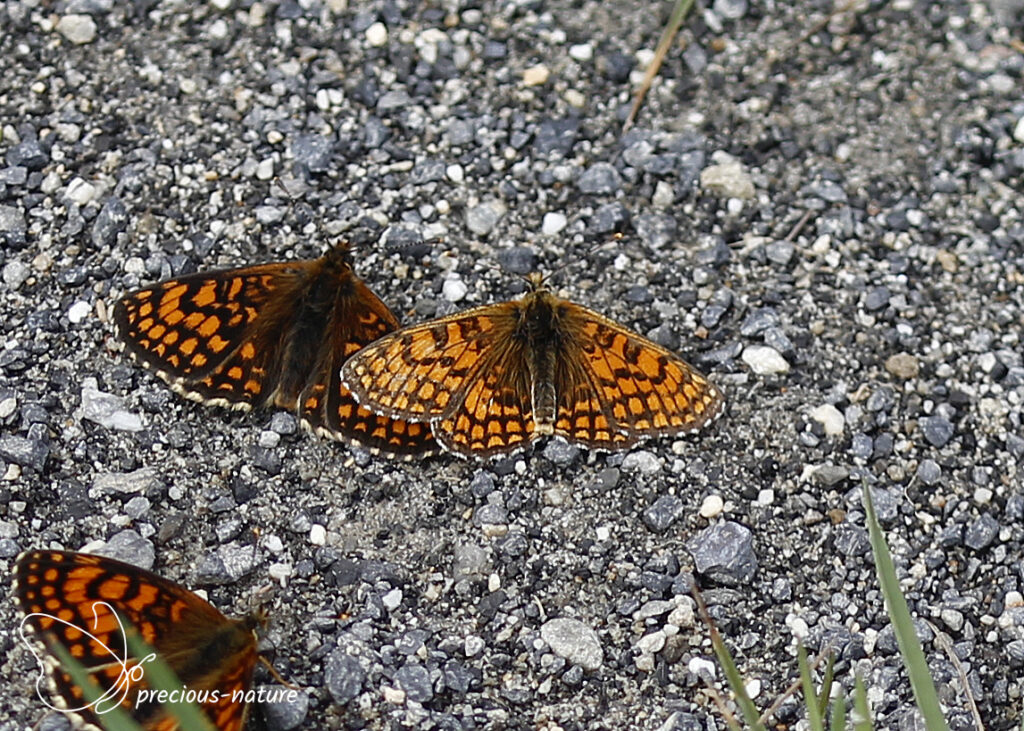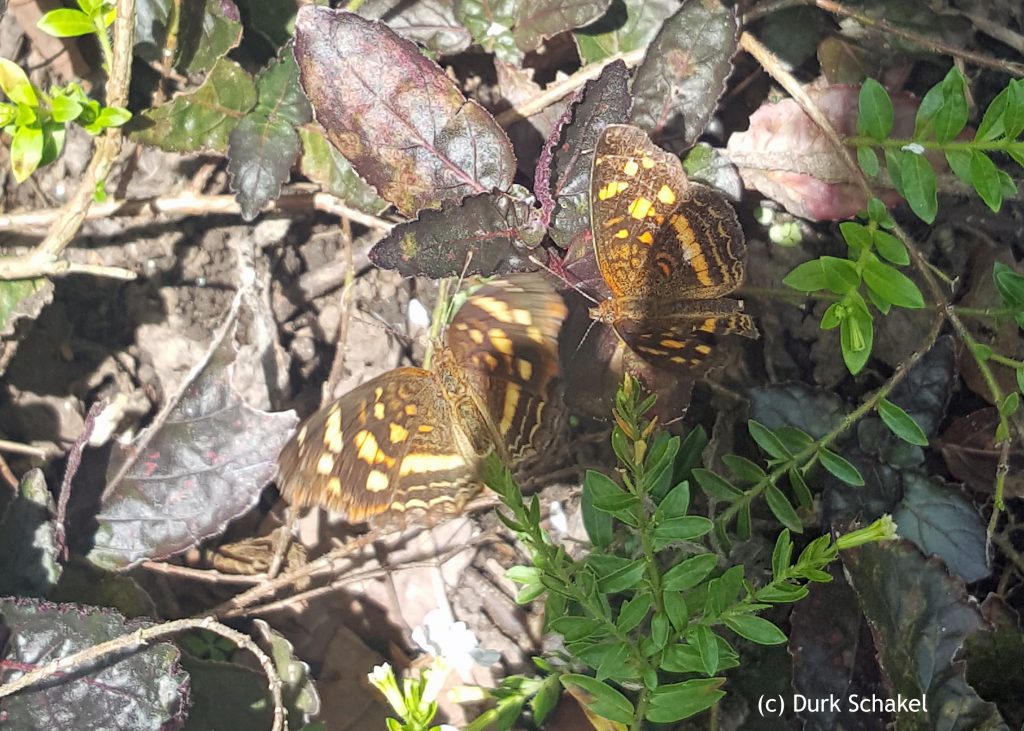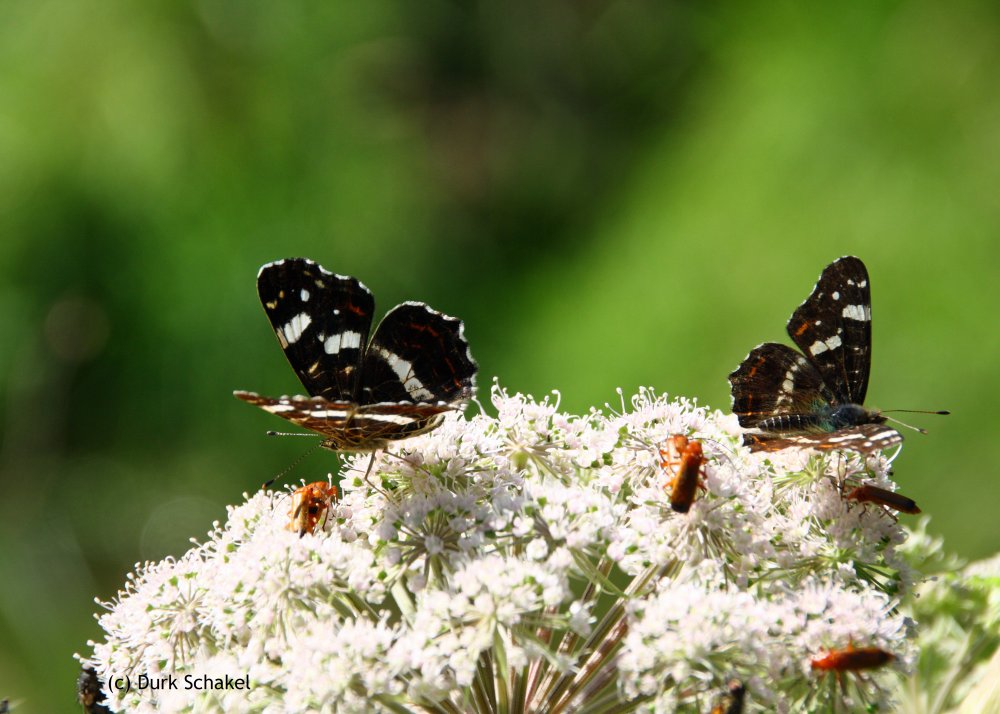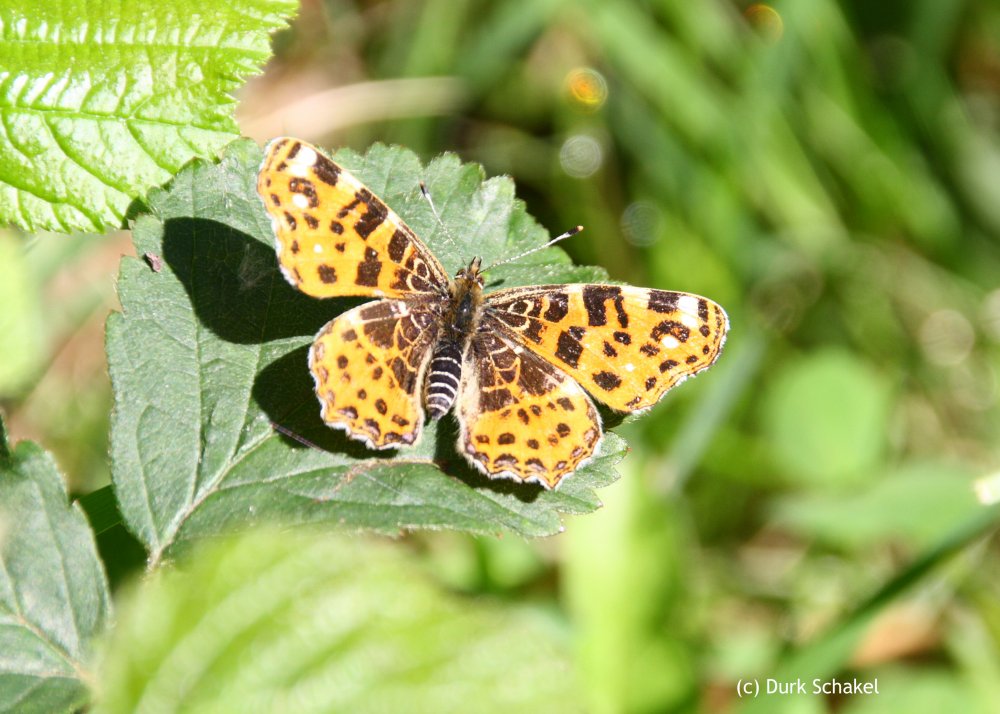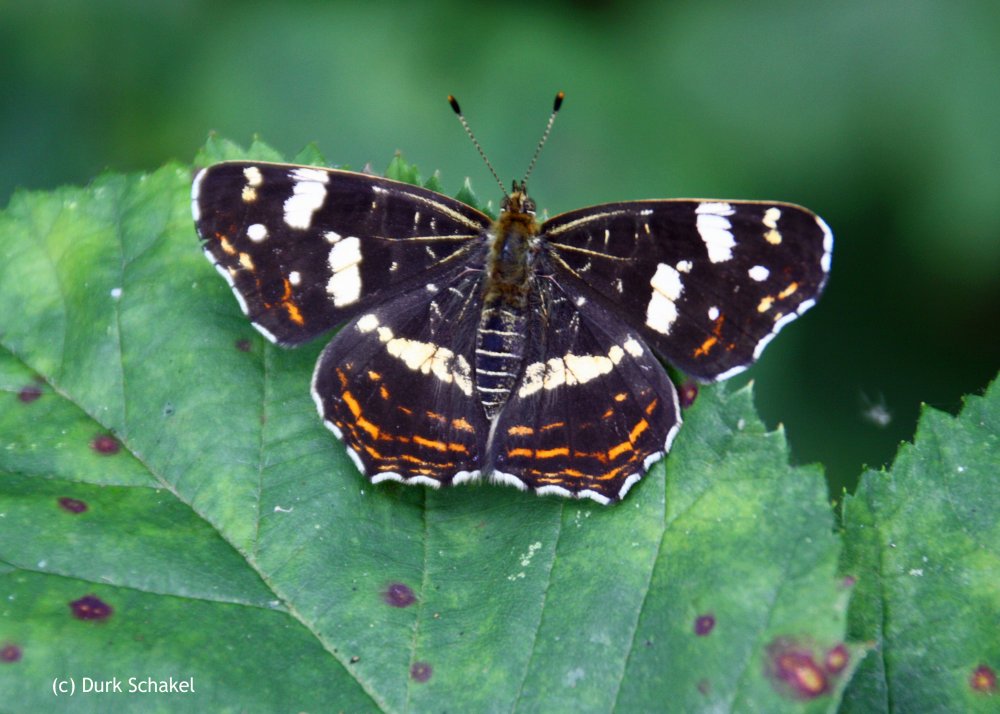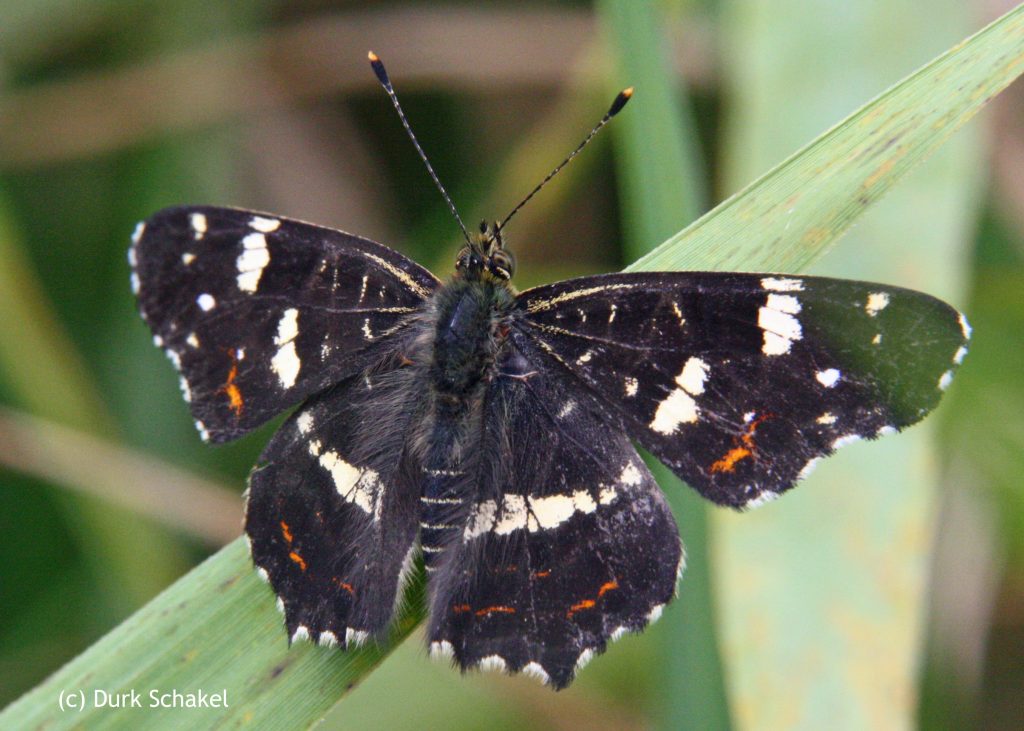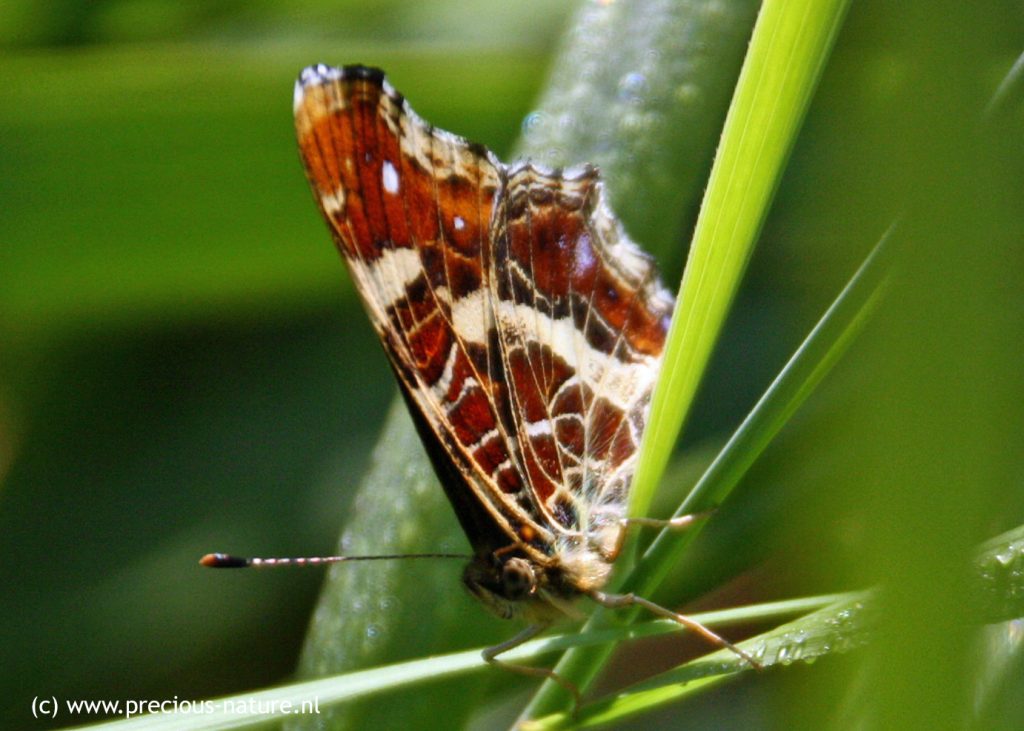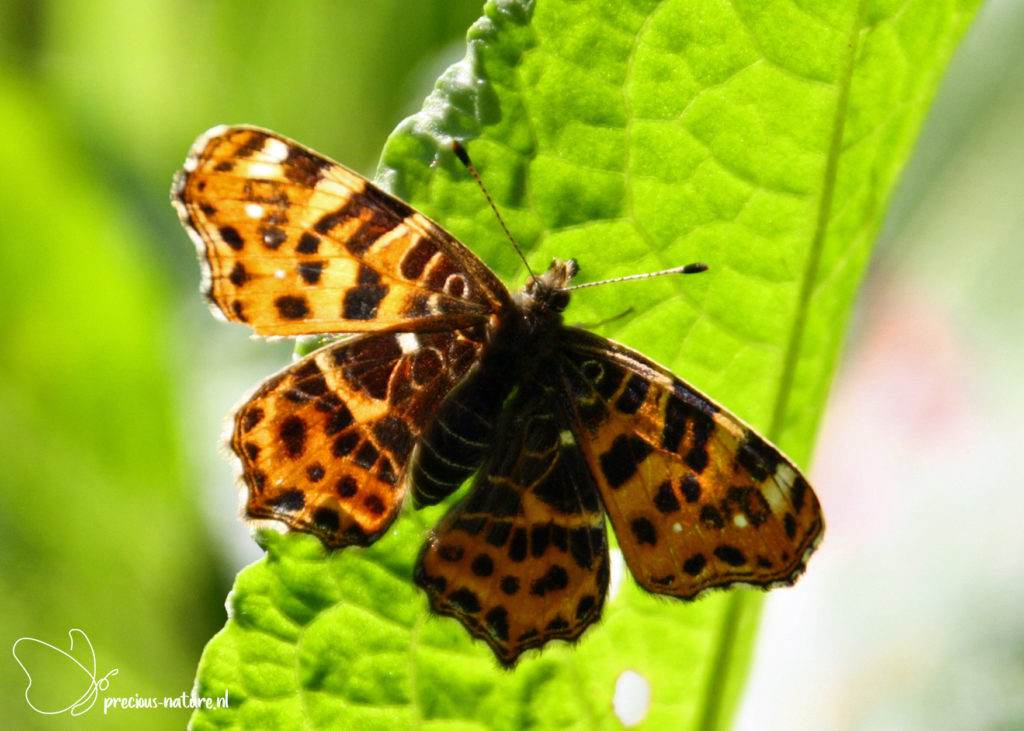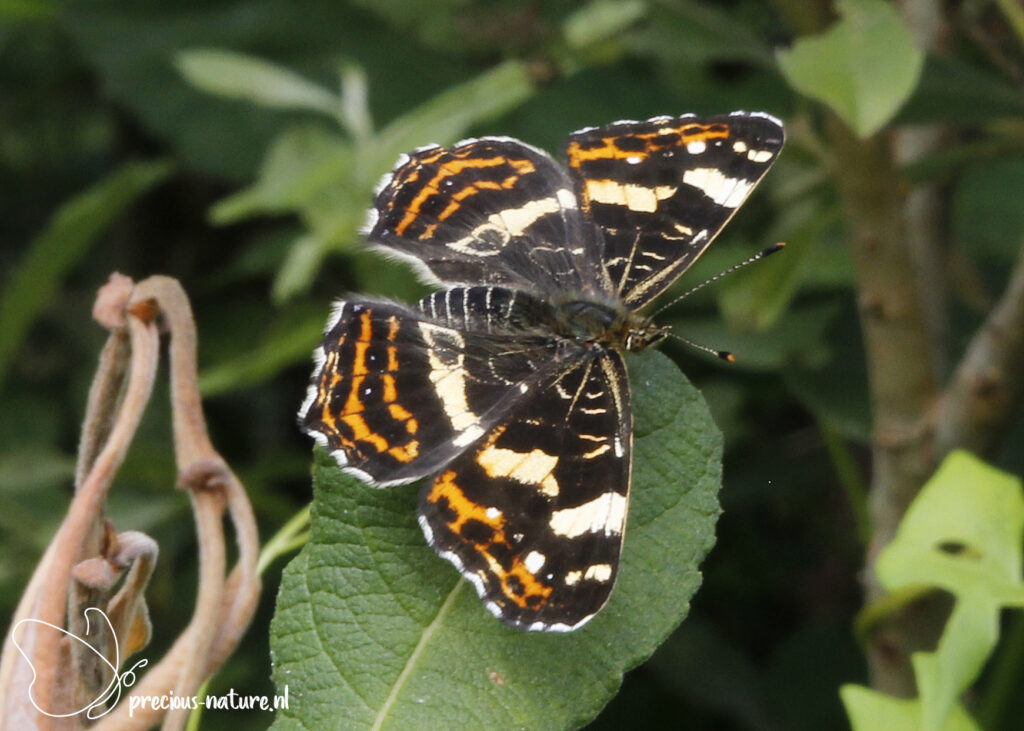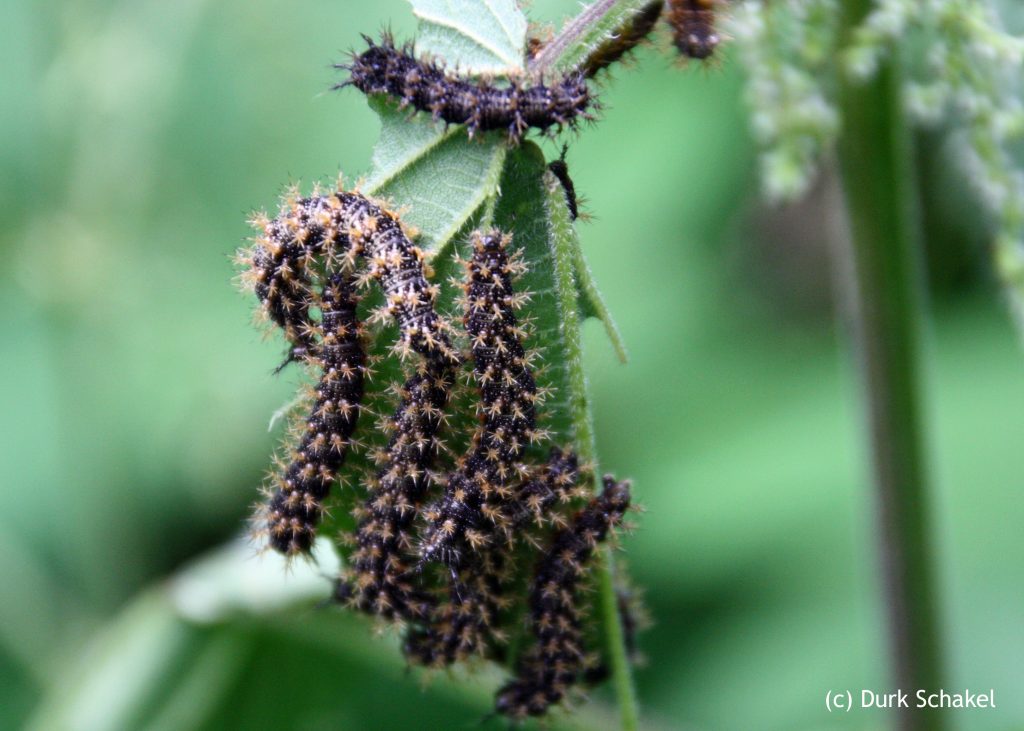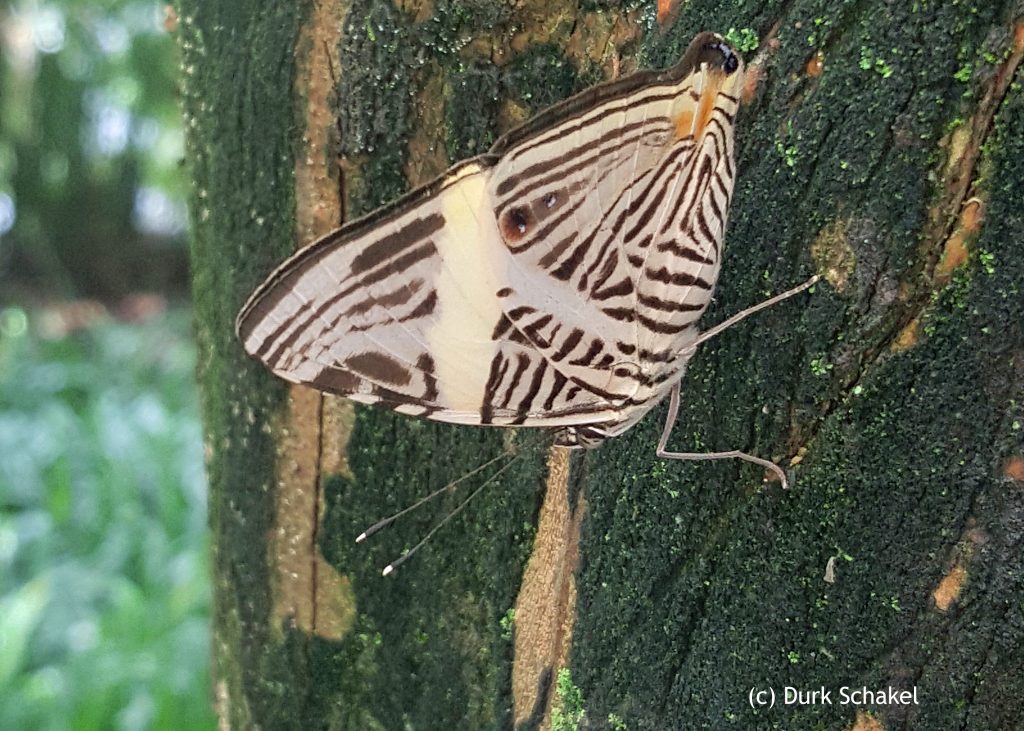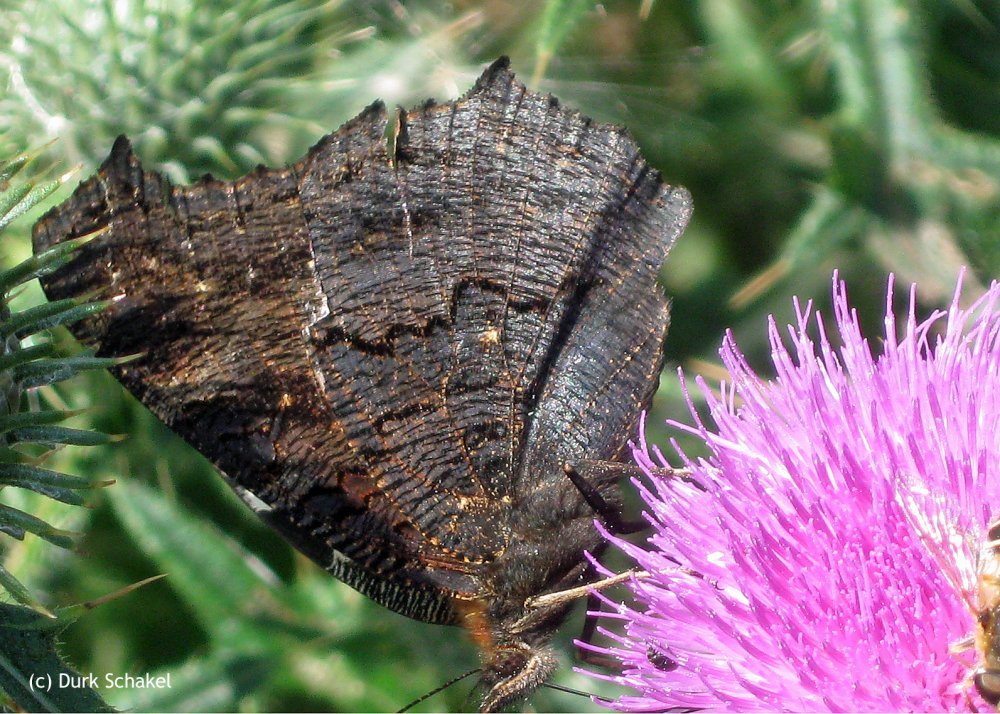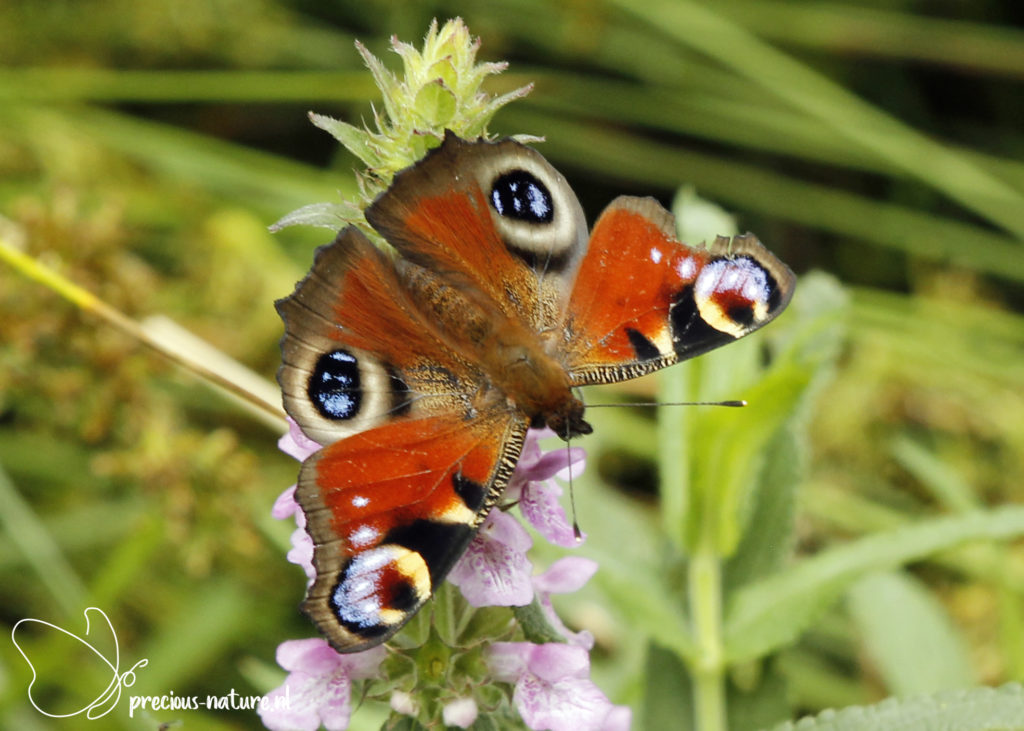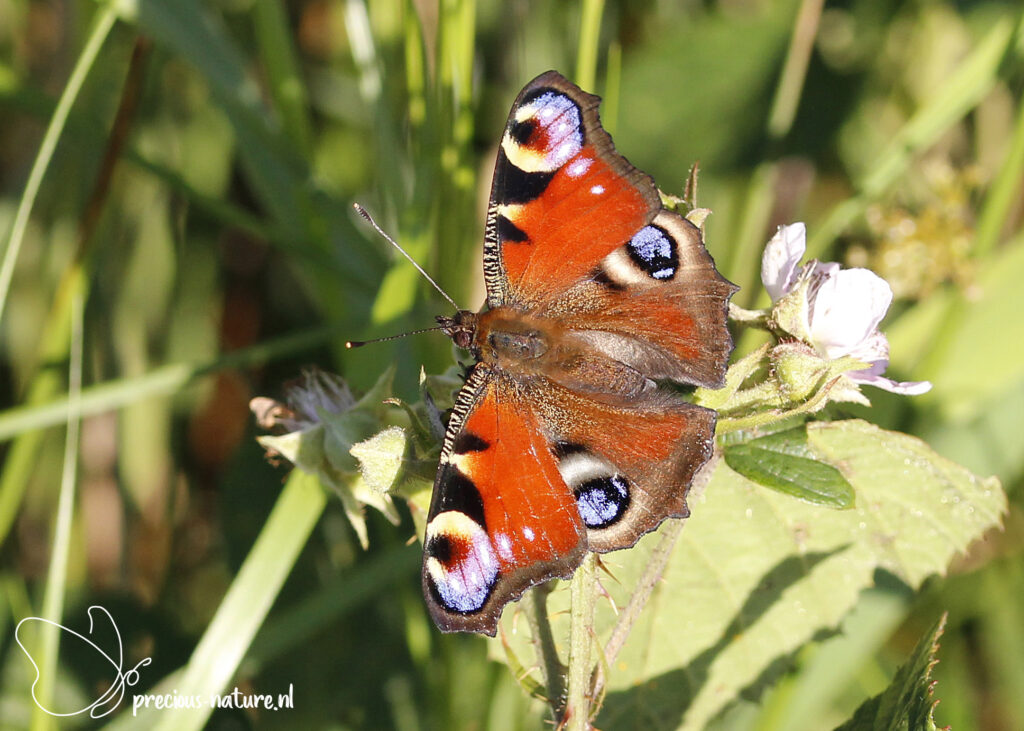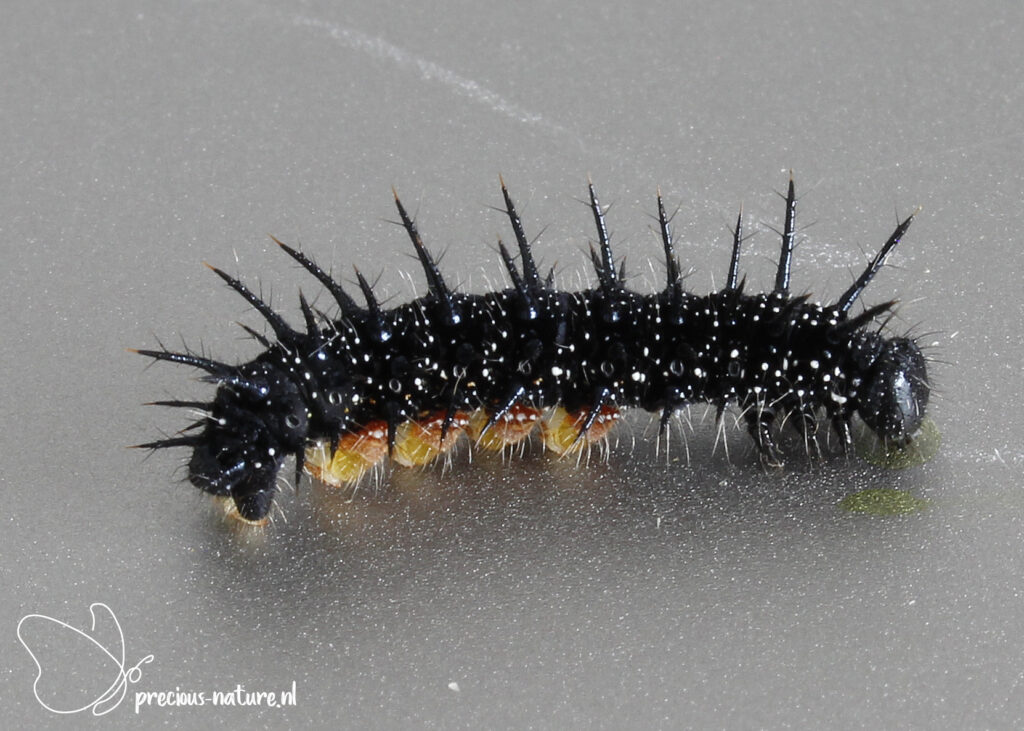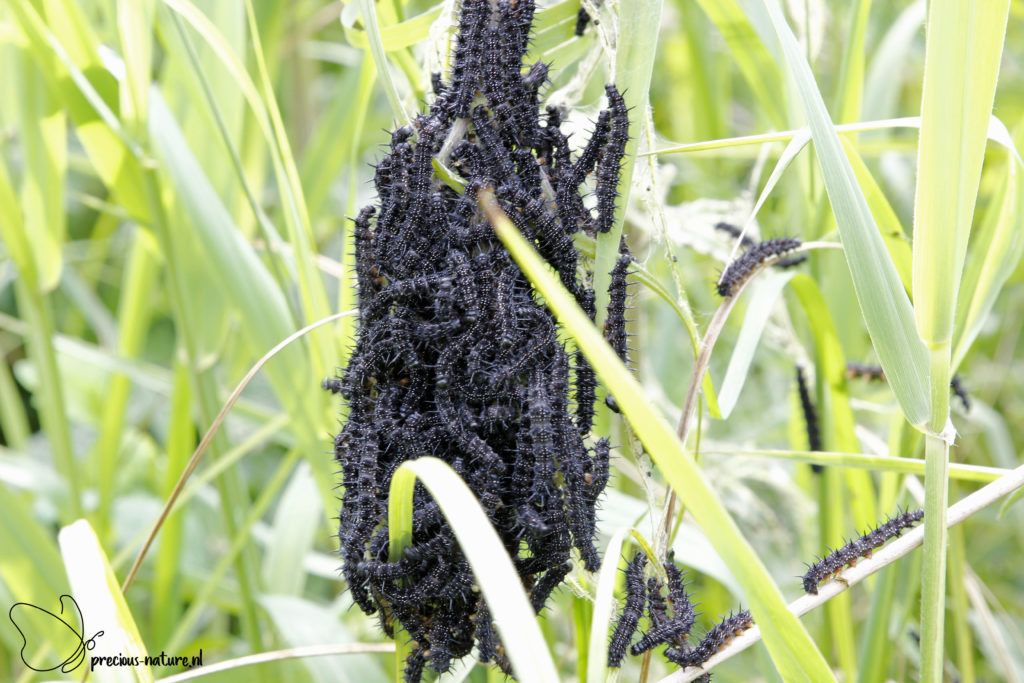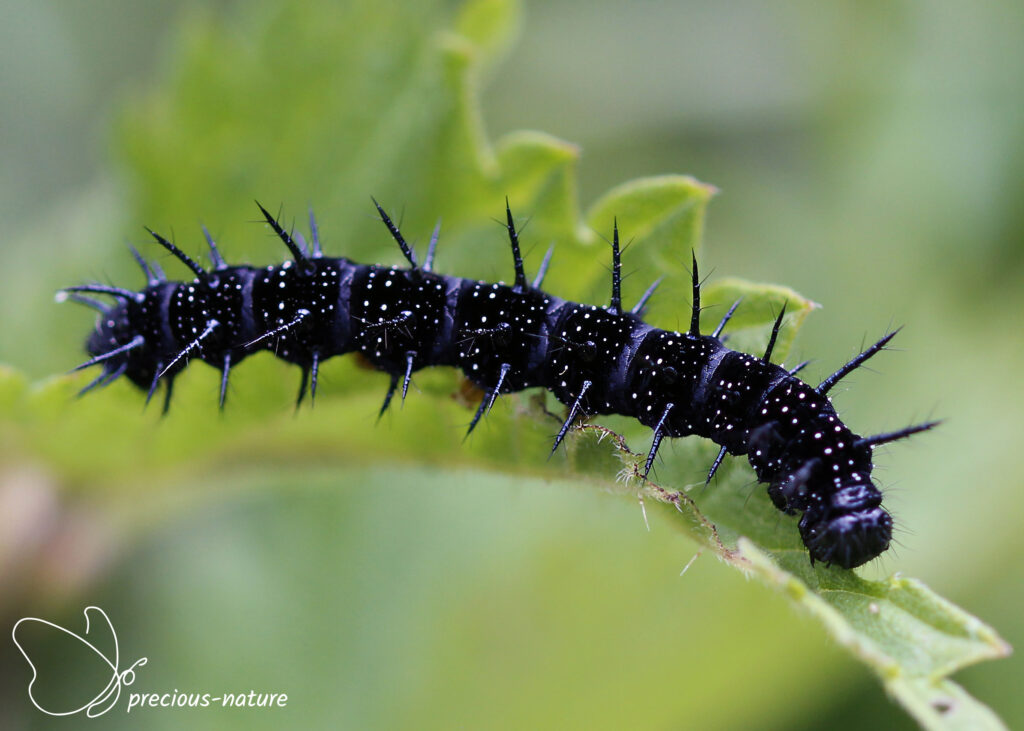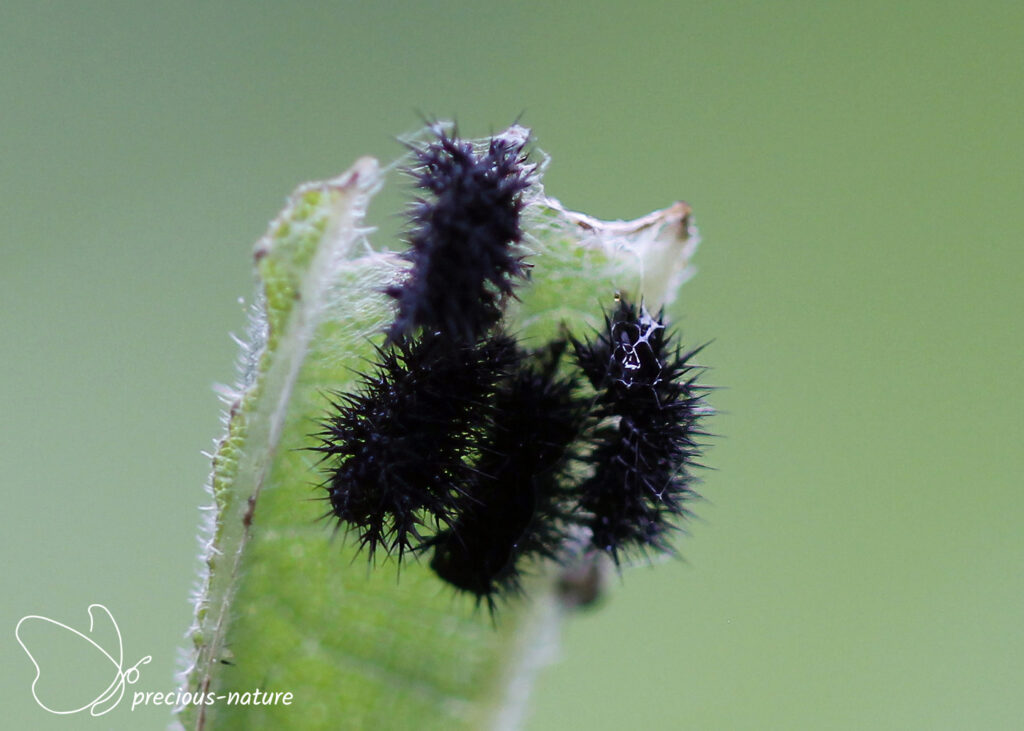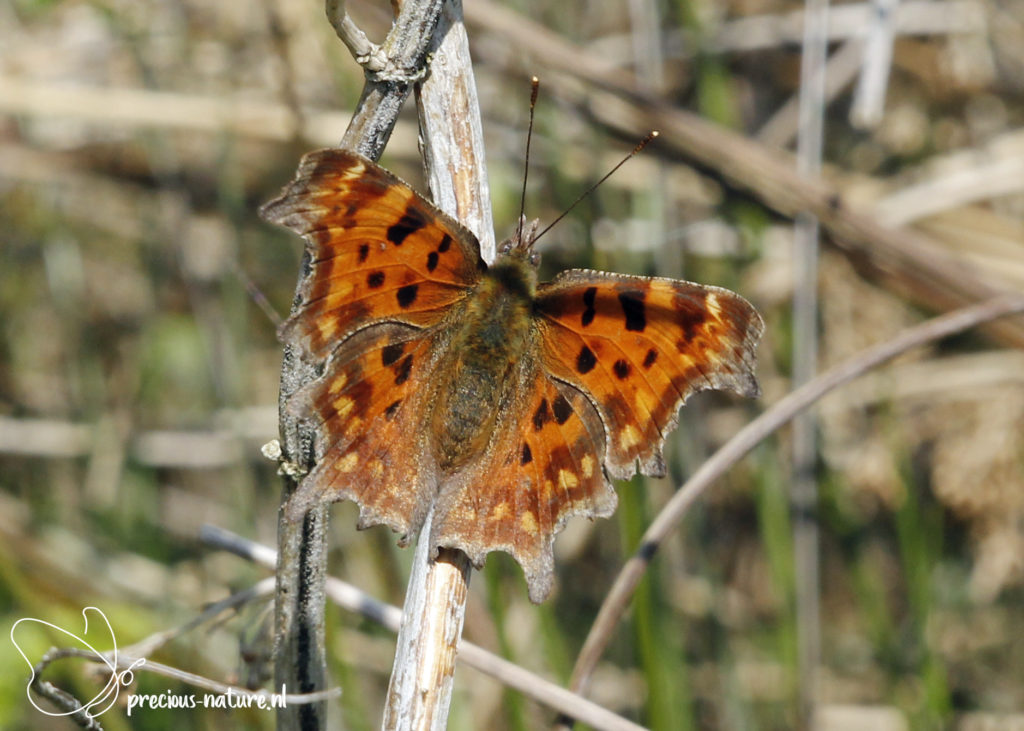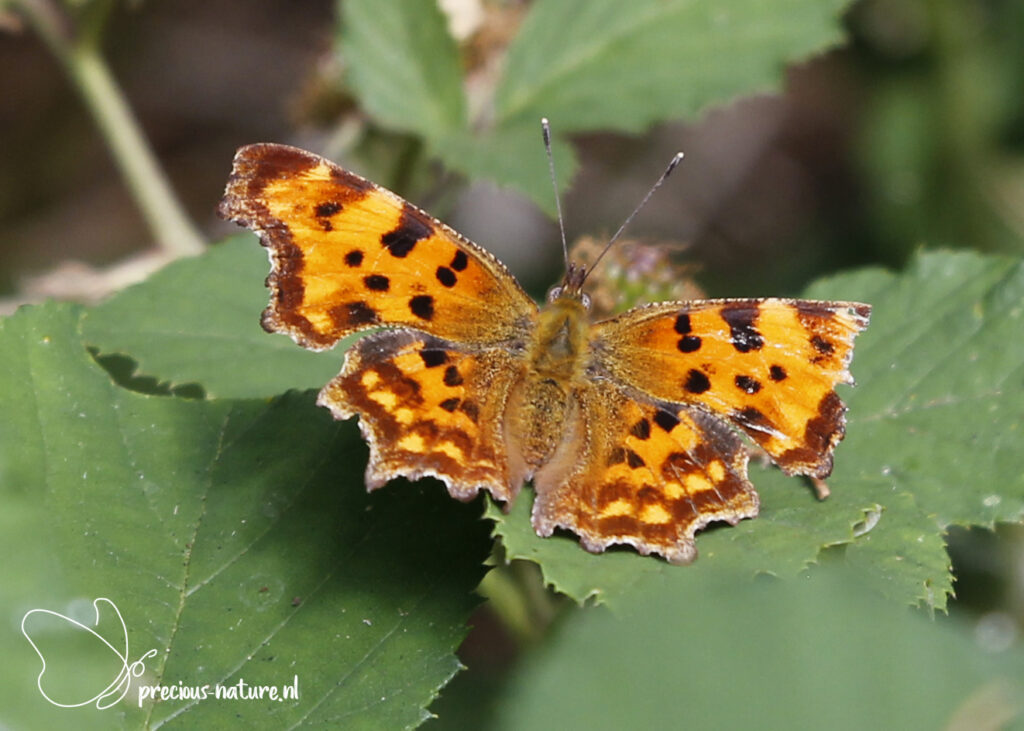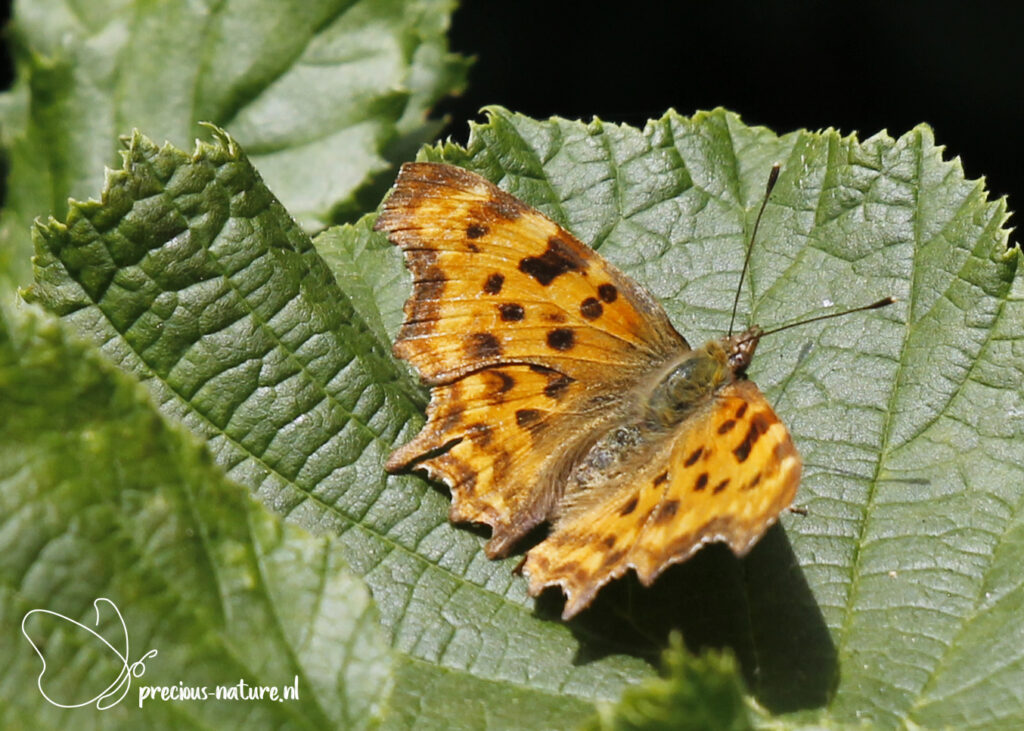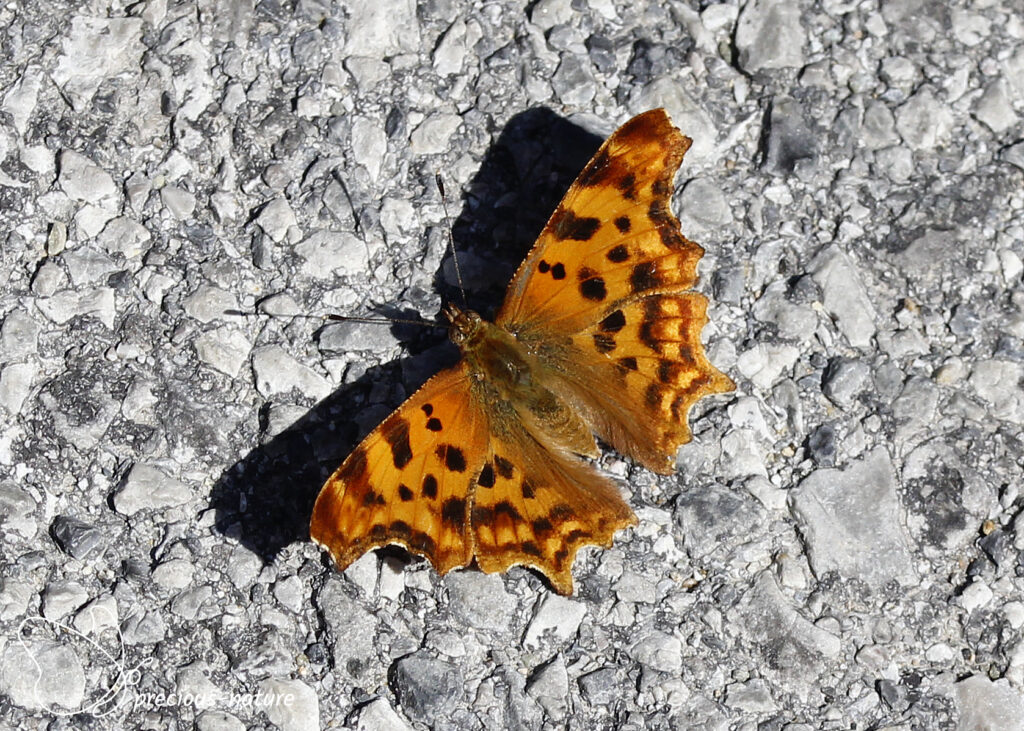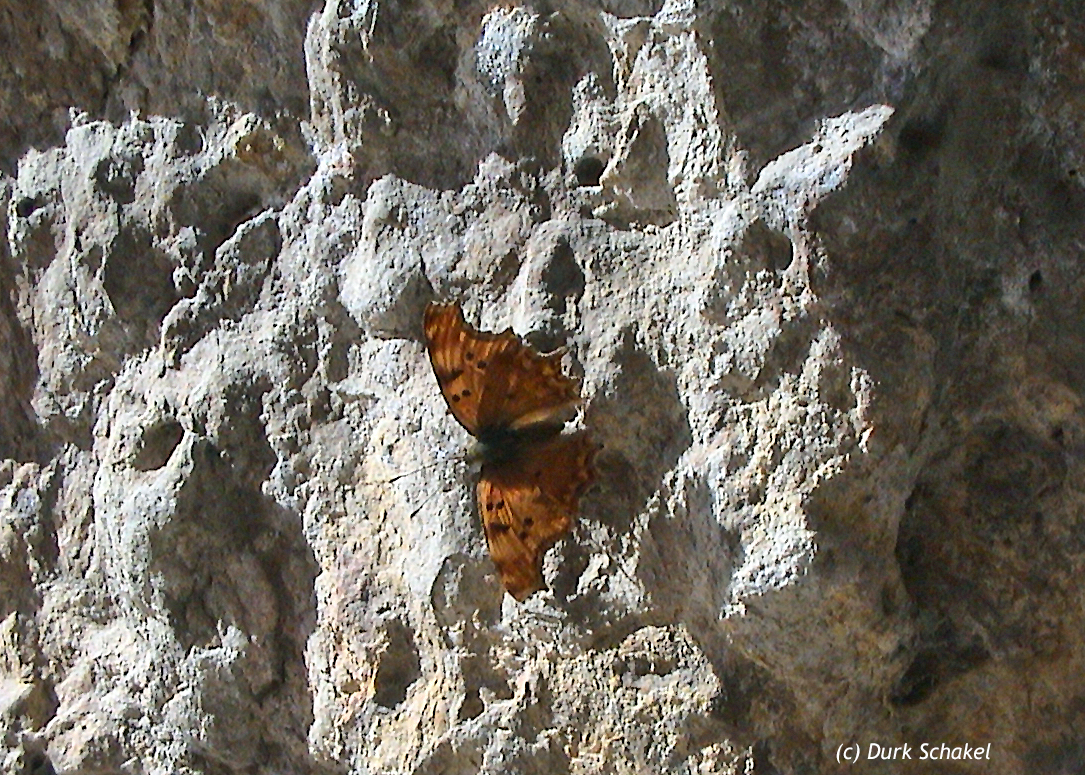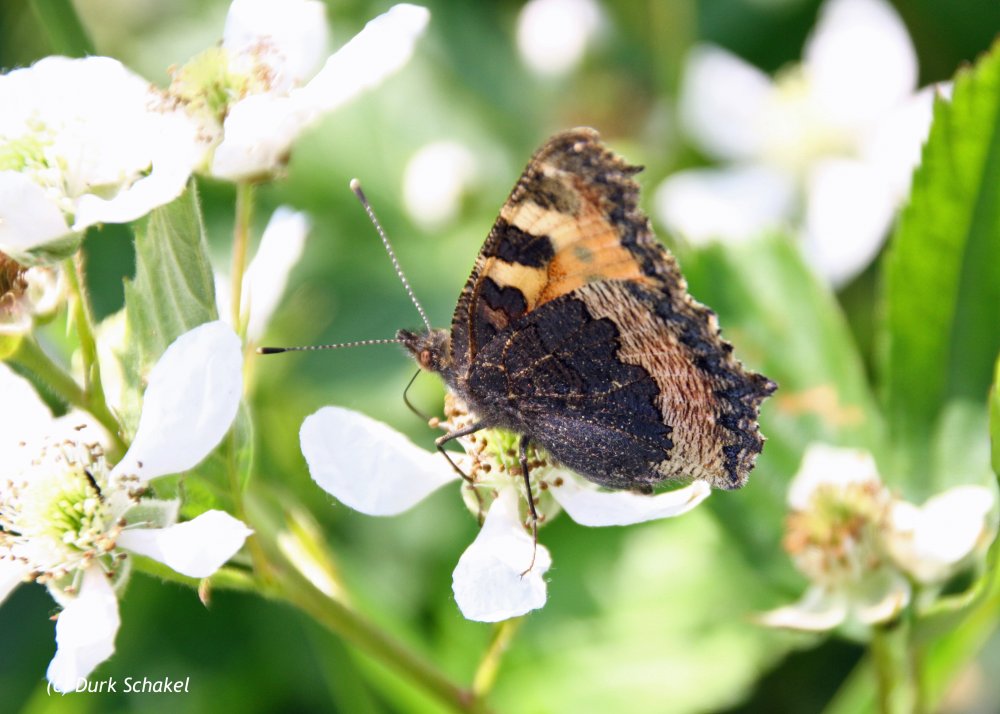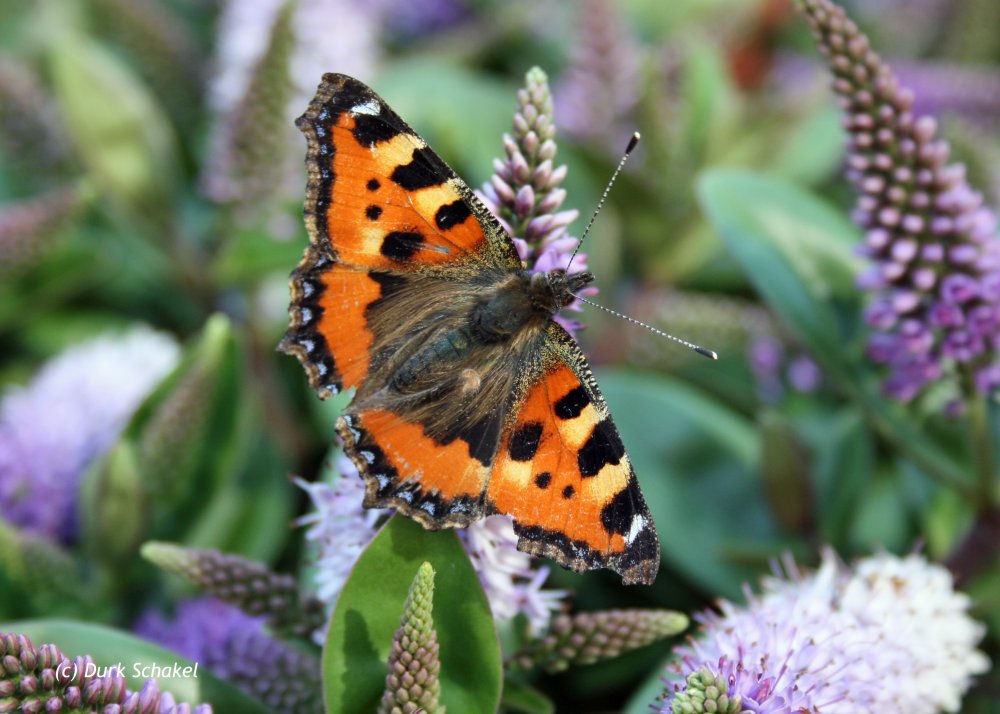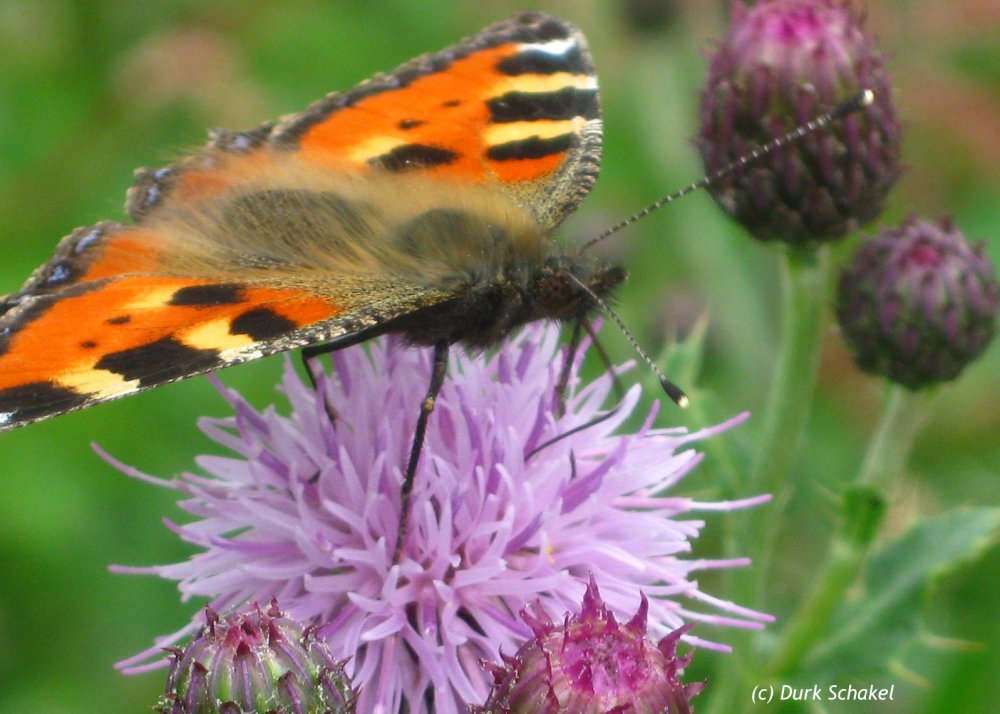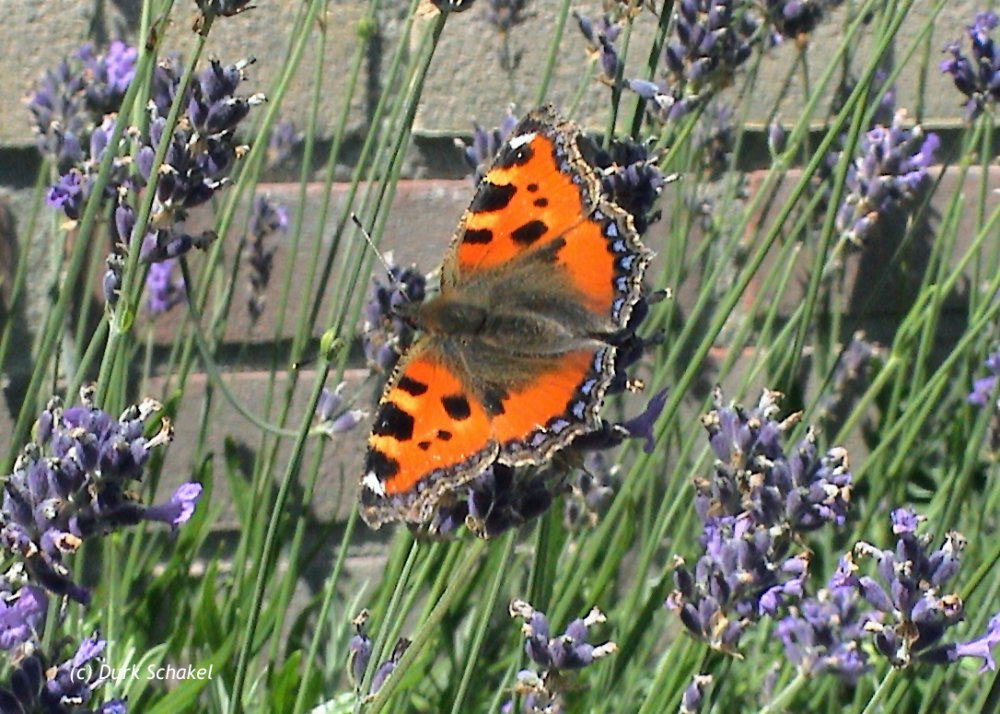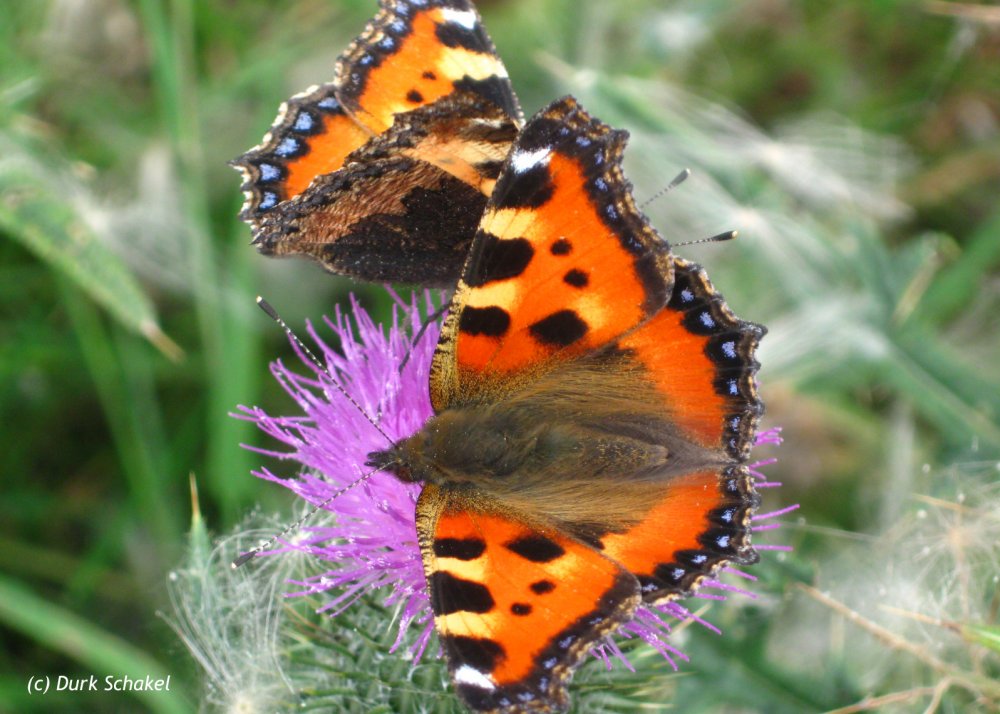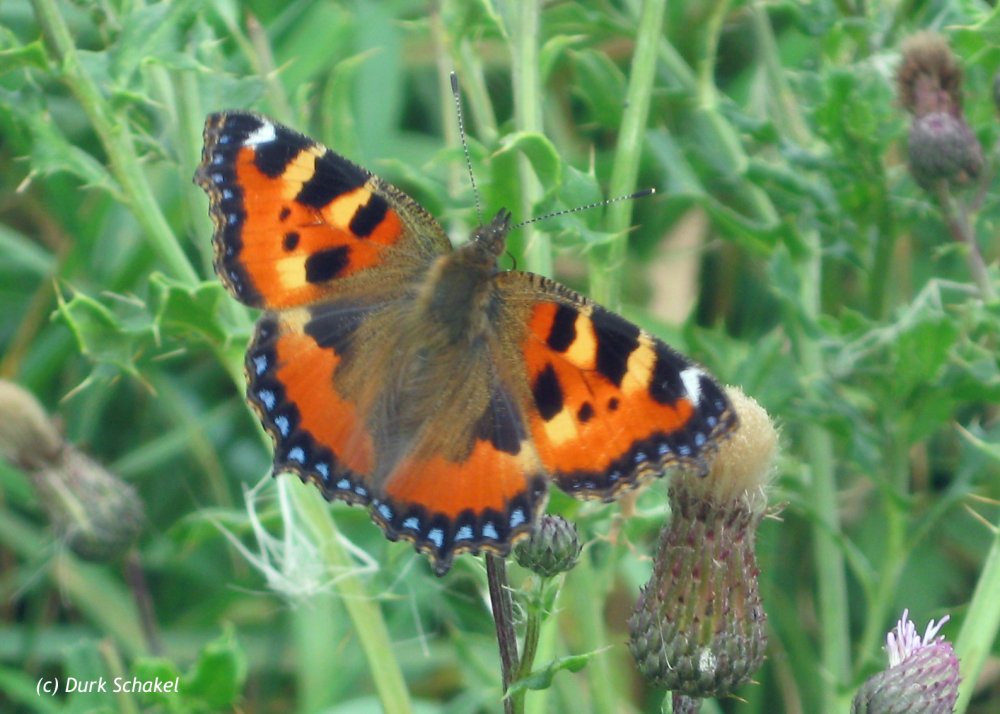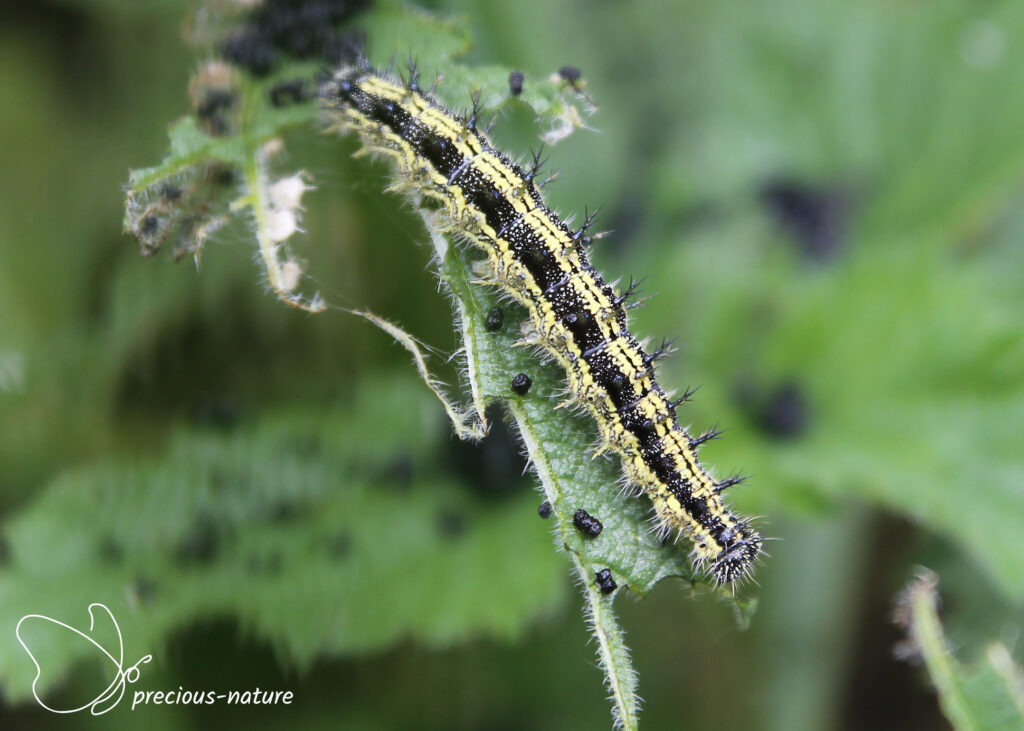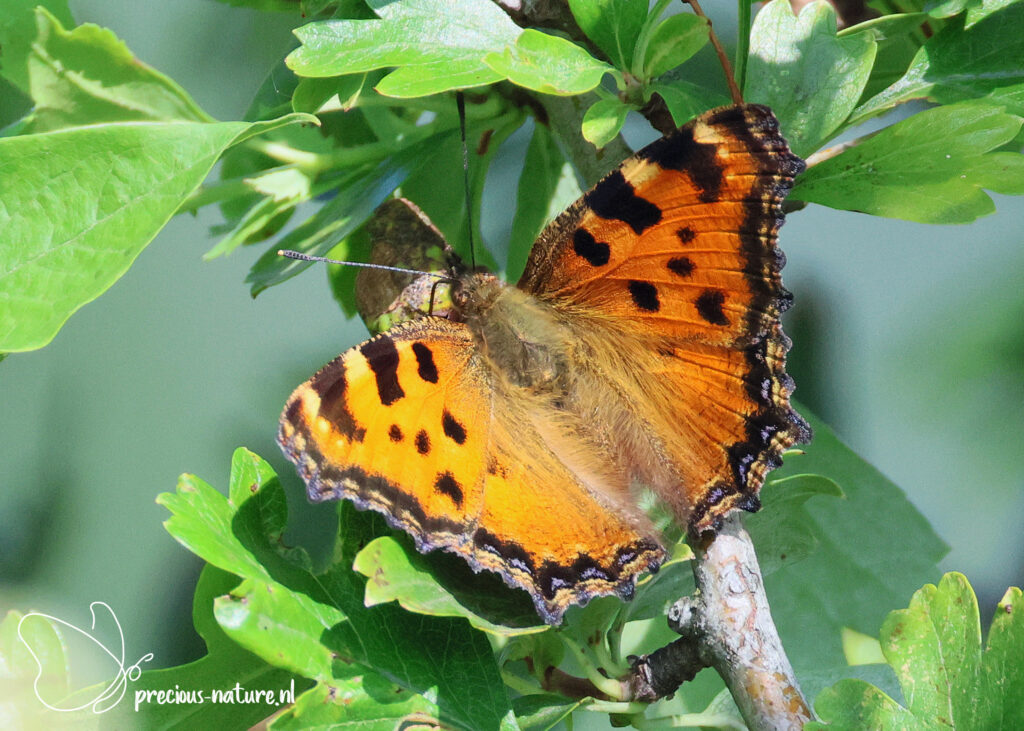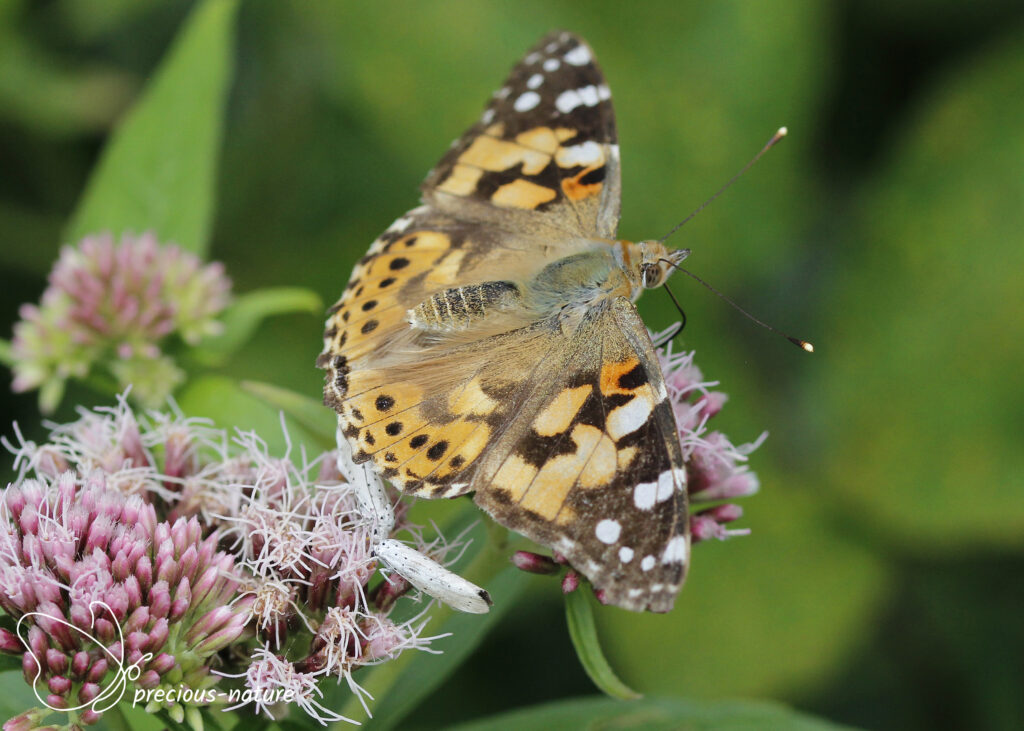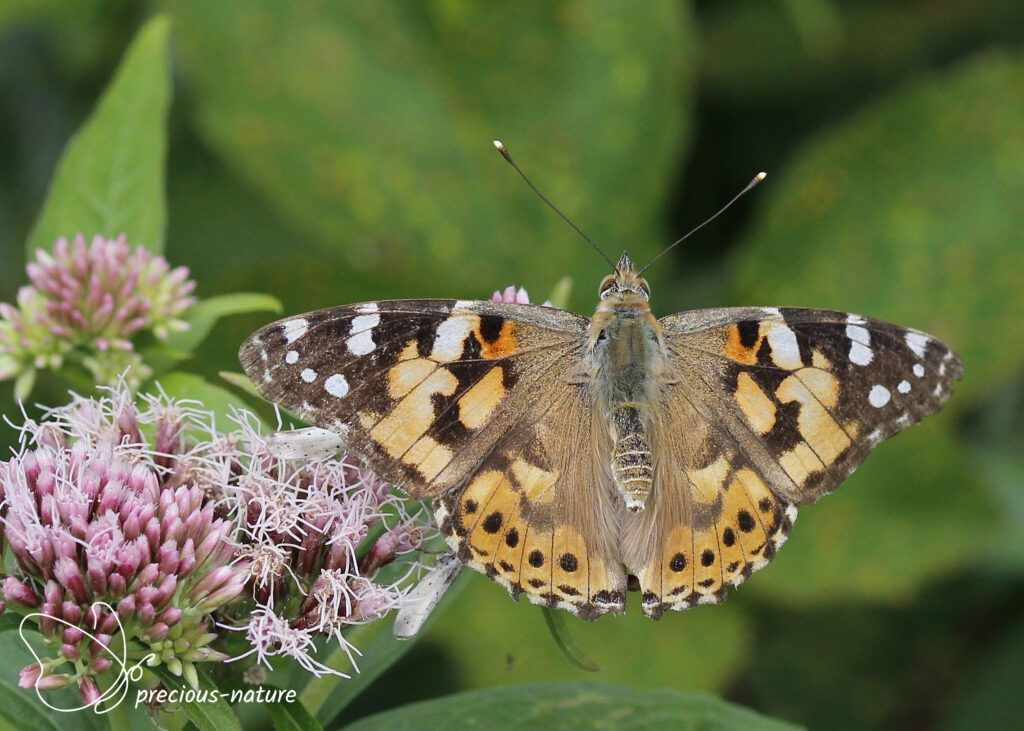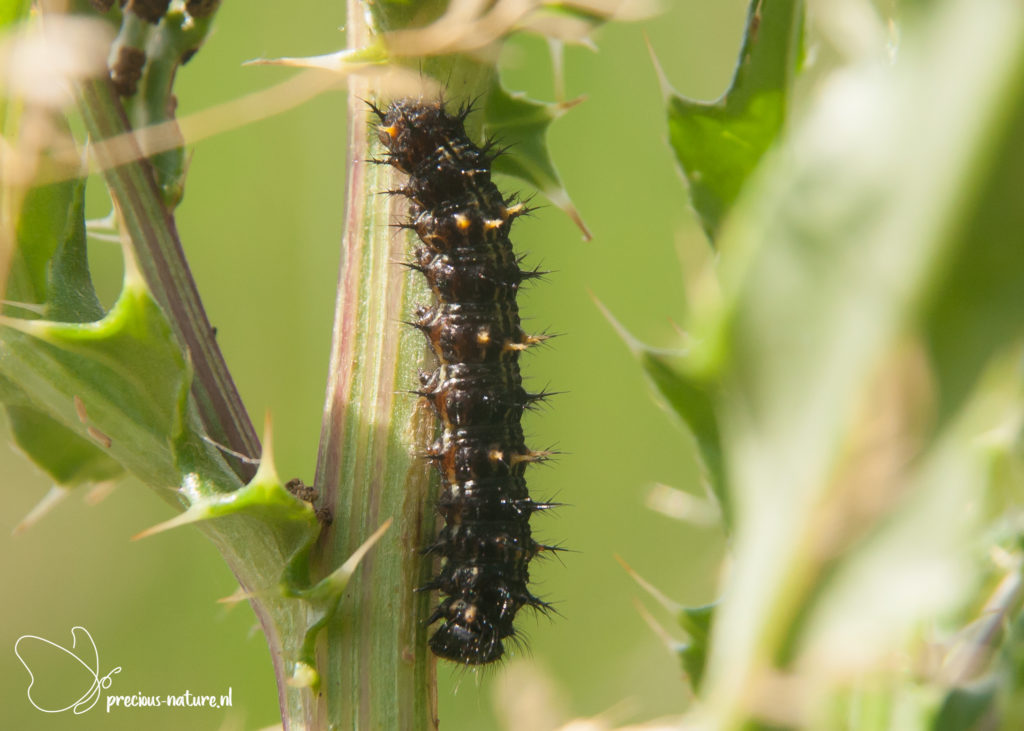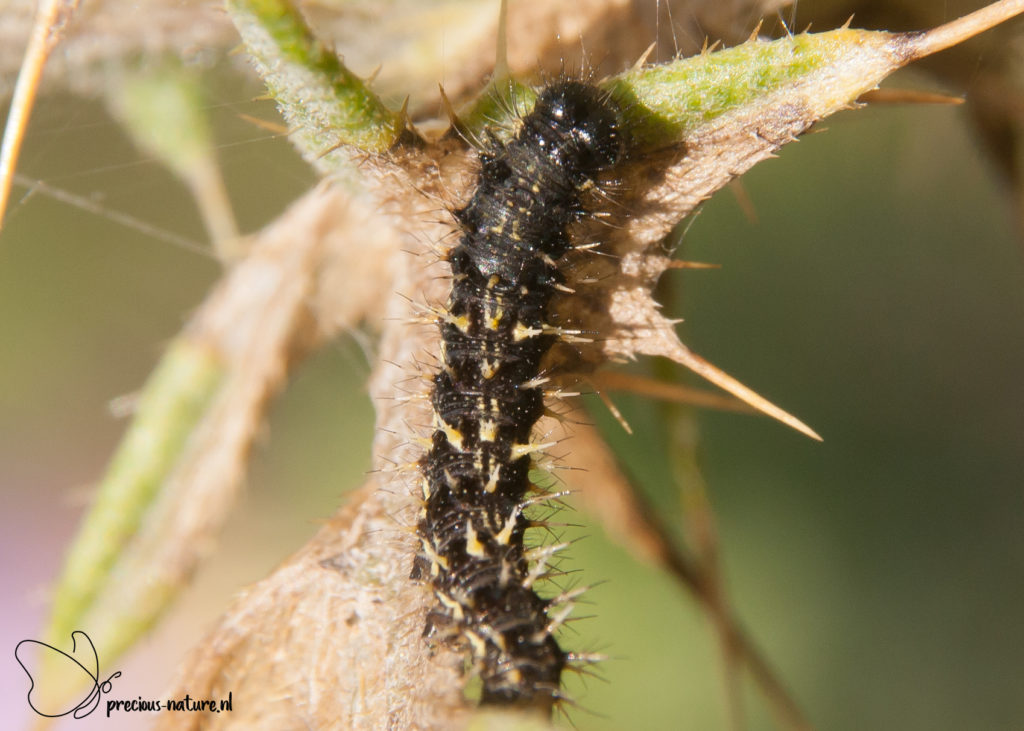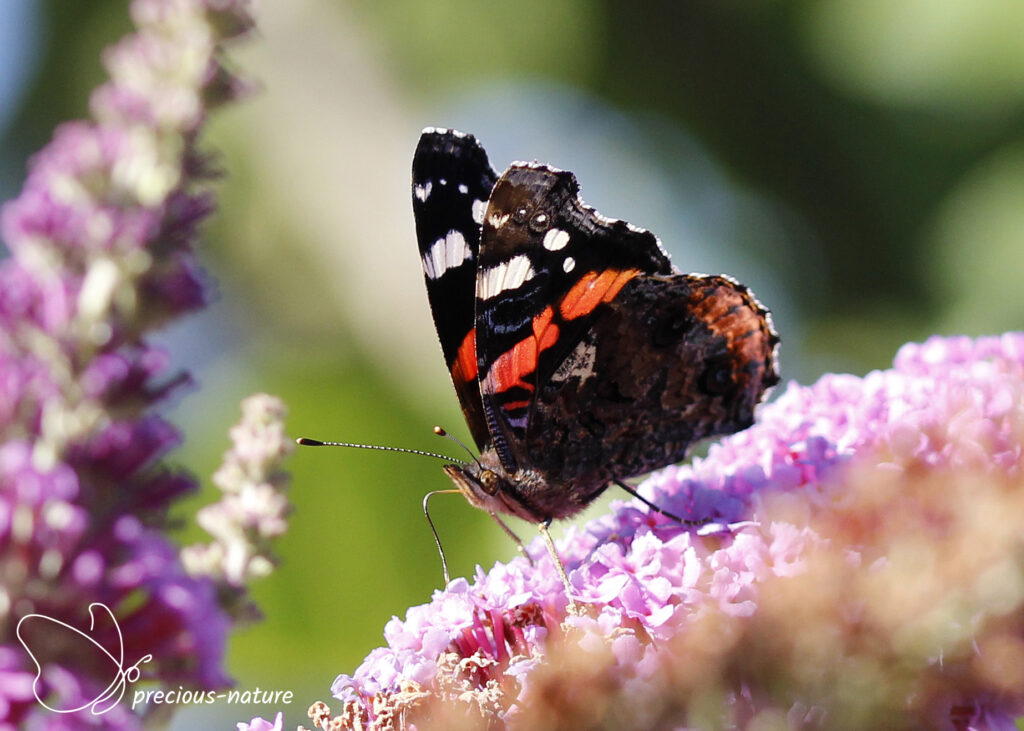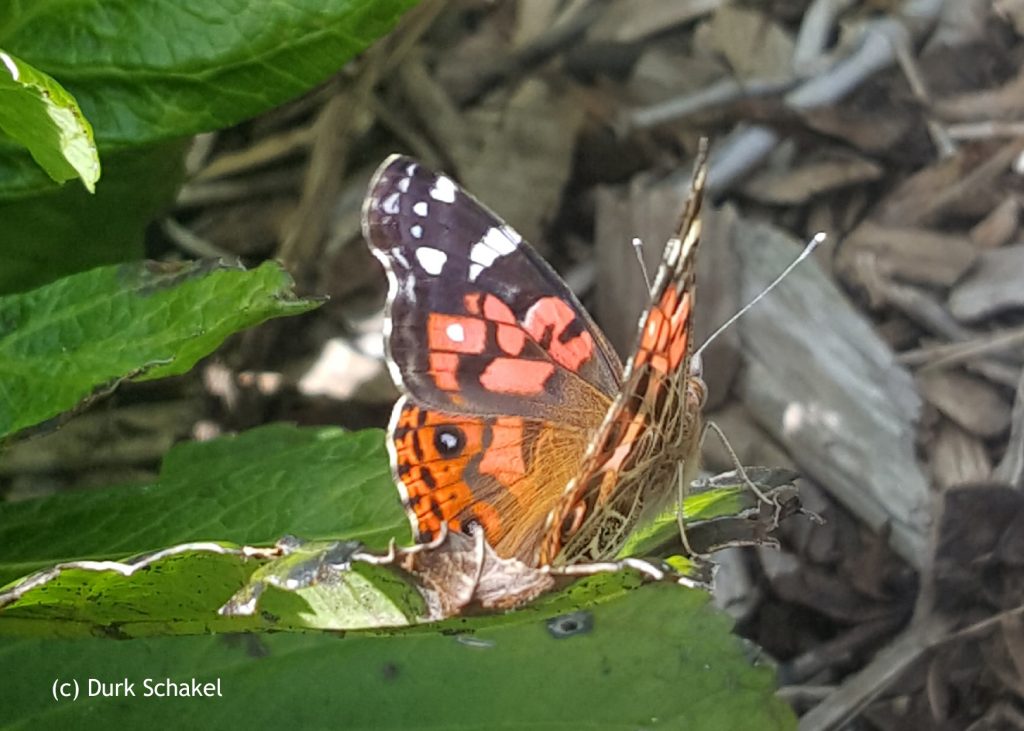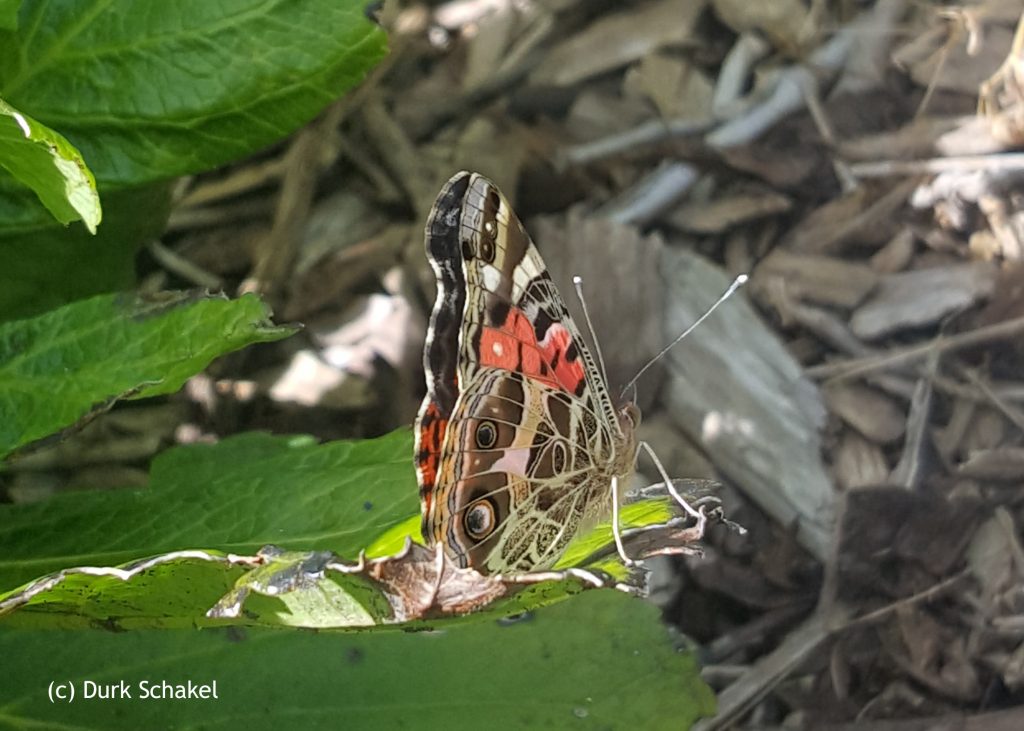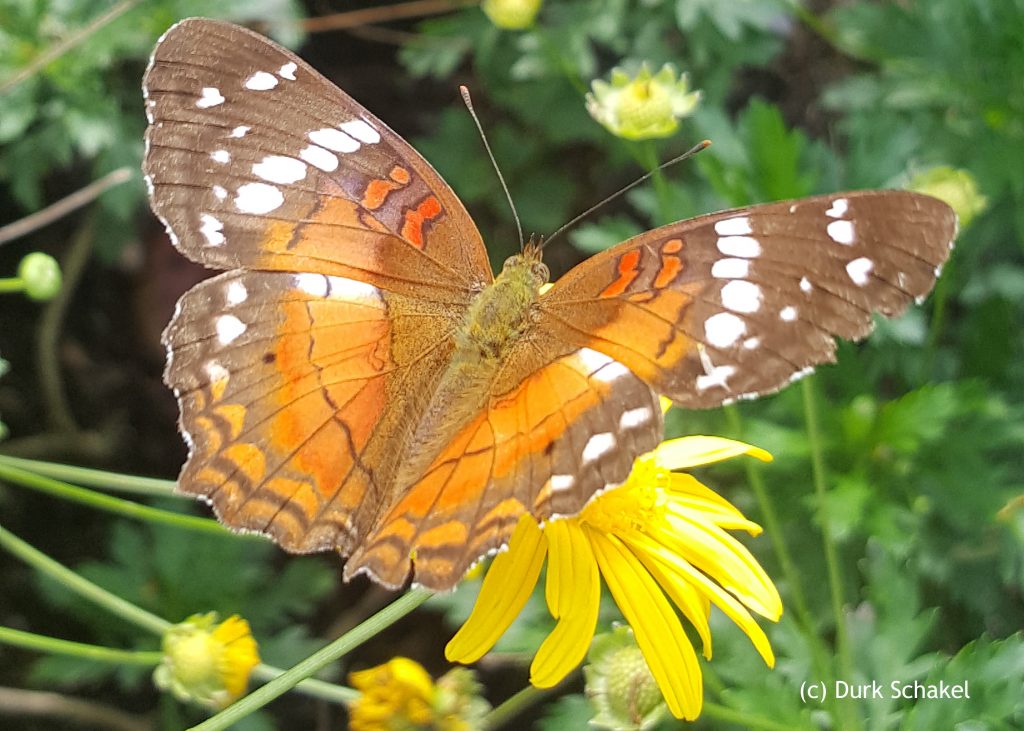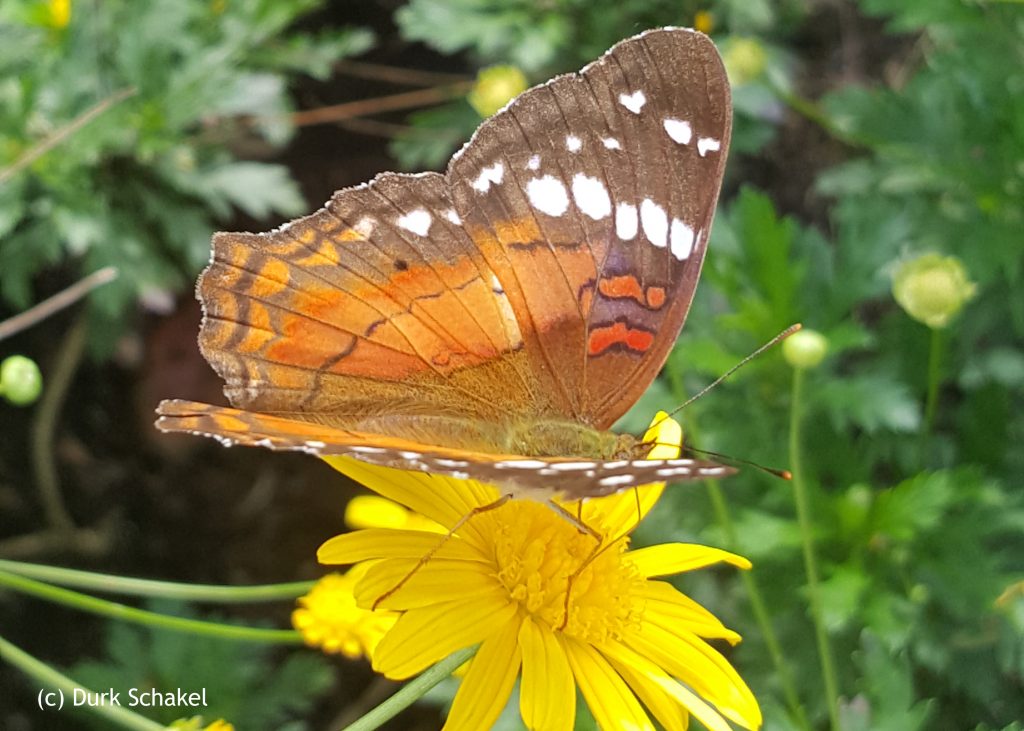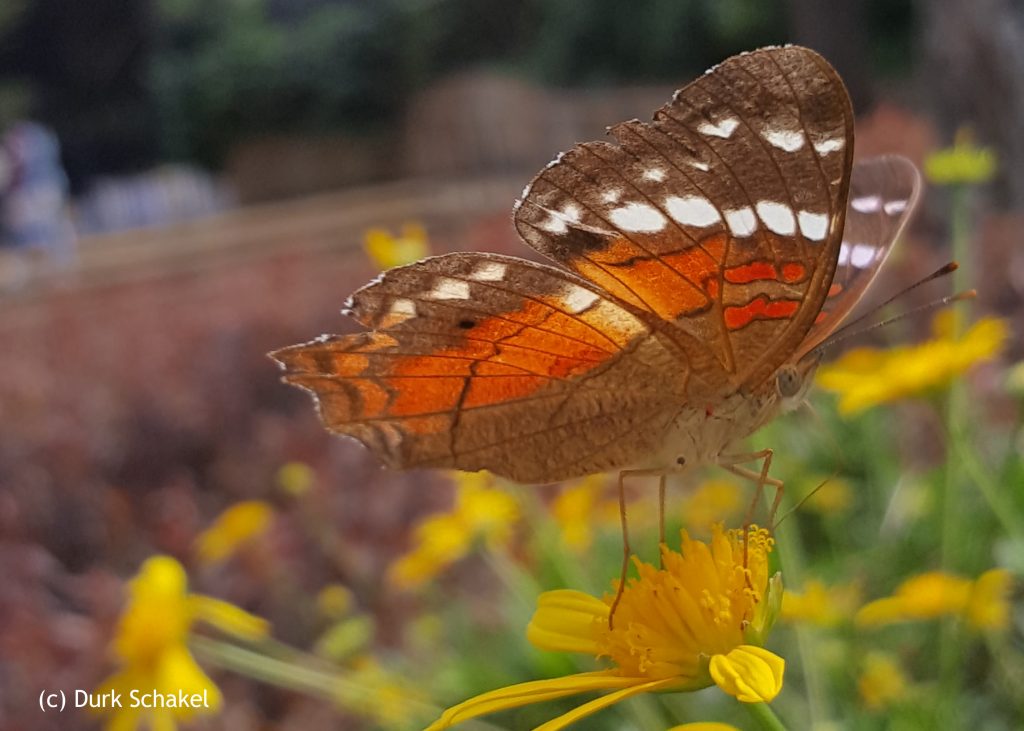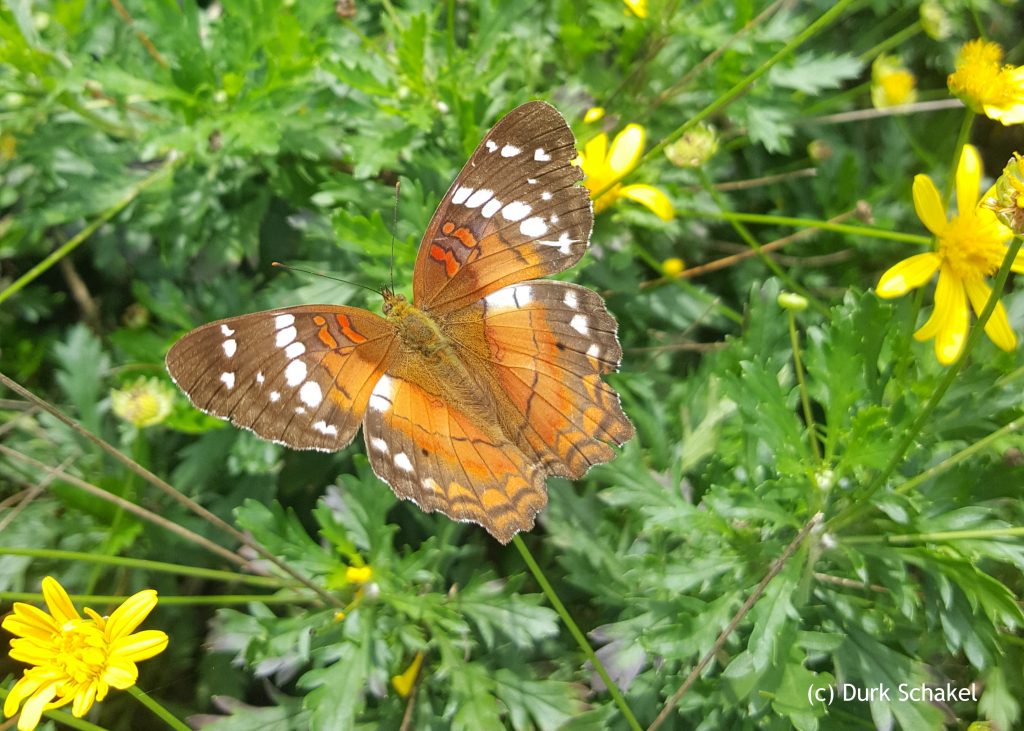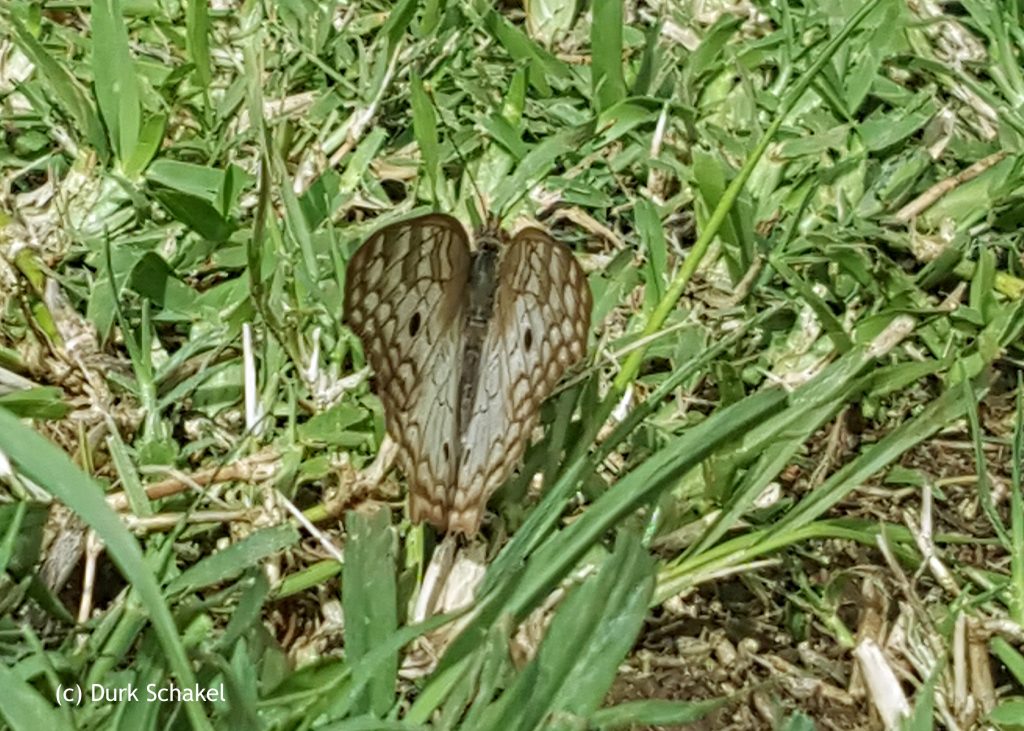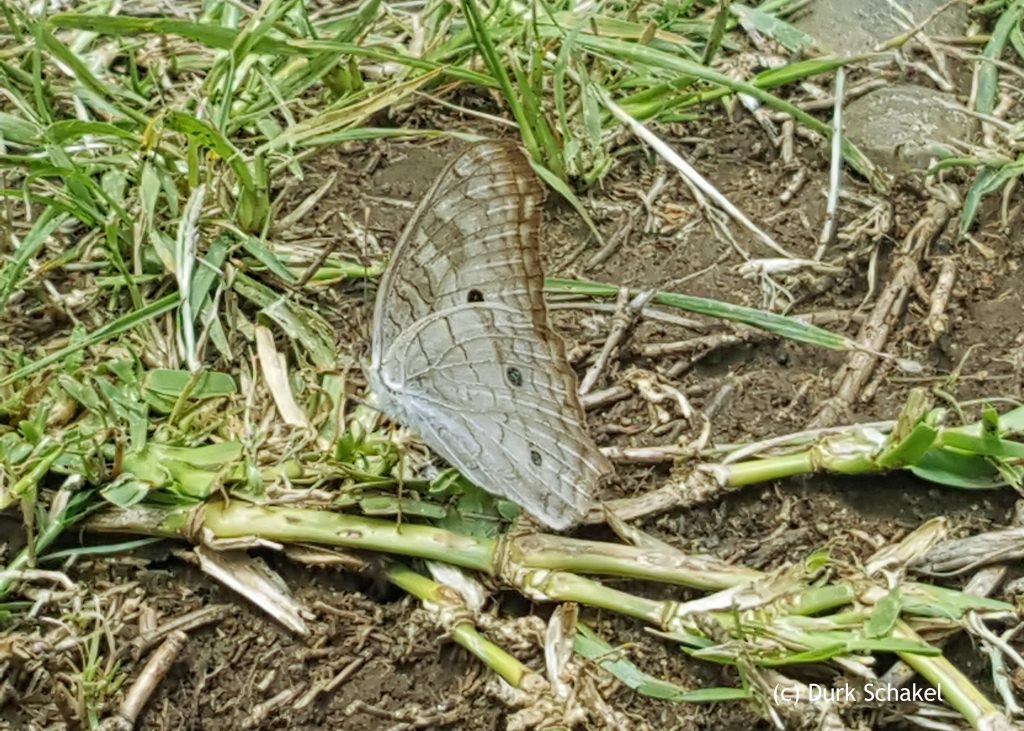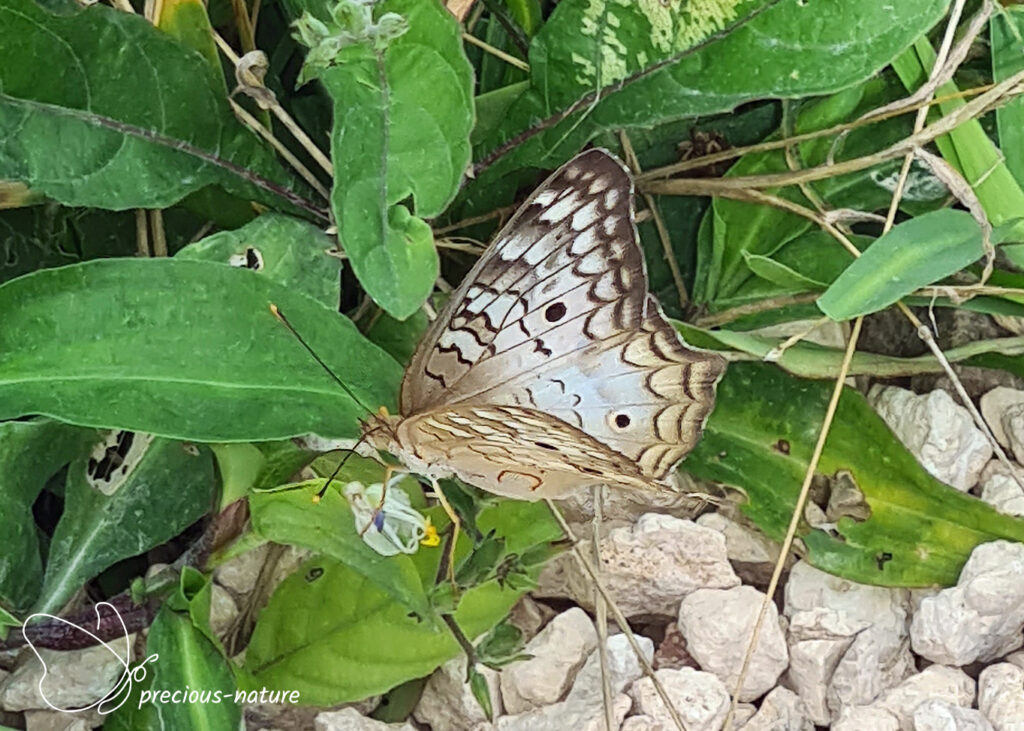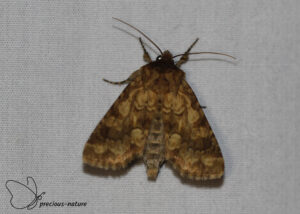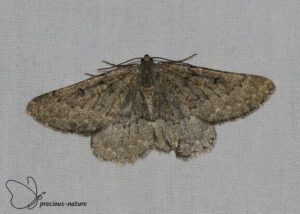True brushfoots and the smaller fritillaries (Nymphalinae) belong to the Brush-footed butterflies (Nymphalidae) family. They are medium—to large-sized butterflies with powerful flight. True brushfoots (Nymphalini) are easy to identify, and most butterflies in this species use nettles to deposit eggs. The smaller fritillaries (Melitaeini) are much harder to identify. For these species, it is crucial to pay attention to essential characteristics.
Tribe: Junoniini
Genus: Junonia
Chocolate Pansy – 2022 (INA)
(NCBI-index: 460132)
The Chocolate Pansy (Junonia hedonia) is fairly common in various habitats across Asia, with a widespread presence in nature reserves, as well as in urban and suburban areas. It flies in the usual gliding manner, and typically, several individuals can be seen together in one location. In sunny conditions, they habitually open their wings wide to sunbathe while resting in a high place. The upper side of the wing is orange-brown, with prominent dark bands running from the leading edge to the inner edge and becoming less broad. You can see several brown circles with a dark dot on the top of the hindwing. The back of both wings is dull brown, and a black stripe runs across both wings that connects seamlessly from the forewing to the hindwing. On the underside of both wings are several yellow-brown circles with a yellow dot in the middle. Furthermore, the white spot on the hindwing stands out. The wingspan is 55-60 mm. Host plant: Creeping Ruellia. Dutch name: Bruine aurelia. Frisian name: –
Tribe: Melitaeini
Subtribe: Euphydryina
Genus: Euphydryas
Asian Fritillary – 2024 (CH)
(NCBI-index: 104511)
There is no other similar species with the same distribution areas or the exact habitat requirements as the Asian Fritillary (Euphydryas intermedia). The species is only found in the Alps, where it occurs sporadically and is generally difficult to locate. On the last day of the visit to the Swiss Alps, it finally happened. First, a specimen flew around, but then landed high up in a tree. When chasing another target species, a very fresh specimen suddenly sat nearby on some flowers. In the Asian Fritillary, the dark post-discal spots on the hindwing are absent. On the underside of the hindwing, there is a narrow black, often broken line that divides the pale discal band of the hindwing. The submarginal spots on the underside of the forewing form a regular line. The upperside is a mosaic of orange, yellow and brown areas arranged by colour in lines. The flight period spans one generation, from June to early August, and the wingspan ranges from 32 to 42 mm. Host plant: Honeyberry. Dutch name: Oranjebonte parelmoervlinder. Frisian name: Oranjebûnte parlemoerflinter
Flying period:

Tribe: Melitaeini
Subtribe: Euphydryina
Genus: Euphydryas
Scarce Fritillary – 2025 (IT)
(NCBI-index: 104512)
A rare and vulnerable butterfly, the Scarce Fritillary (Euphydryas maturna) is still found in specific locations. During my trip to the Maritime Alps, I was fortunate enough to see this remarkable species. Initially, it was at a great distance, too distant to photograph properly, before it foraged on a flower at close range. It closely resembles the Asian Fritillary (Euphydryas intermedia). Besides the fact that their distribution areas do not overlap, the difference is clearly visible on the undersides of both the forewing and hindwing. The underside is predominantly bright orange. A row of white spots with a thin black line in the middle can be seen in the postdiscal area of the hindwing. Several white spots are in the basal region. The upperside of the wing is a mosaic of orange-red, yellow, and brown patches arranged in lines by colour. The flight period spans one generation, from late May to early July, and the wingspan ranges from 35 to 48 mm. Host plant: Common Ash. Dutch name: Roodbonte parelmoervlinder. Frisian name: Readbûnte parlemoerflinter.
Flying period:

Tribe: Melitaeini
Subtribe: Euphydryina
Genus: Euphydryas
Cynthia’s Fritillary – 2025 (FR)
(NCBI-index: 104506)
The trip to the Maritime Alps was a great success, particularly with the brightly coloured fritillaries. Besides the Scarce Fritillary (Euphydryas maturna), I was also able to add the Cynthia’s Fritillary (Euphydryas cynthia) to my species list. This species, too, is scarce and vulnerable, found only at high altitudes in the Alps. The wing markings are unique, making identification easy. In males, the white markings in the discal and basal areas are characteristic of this species. The female appears very similar from above to the Asian Fritillary (Euphydryas intermedia), but the underside differs. On the underside of the hindwing, the black line in the pale discal band is missing, and it has a black dot in the red postdiscal band in each segment on the upperside and underside of the hindwing. The flight period spans one generation, from late June to early August, and the wingspan ranges from 32 to 42 mm. Host plant: Alpine Plantain. Dutch name: Witbonte parelmoervlinder. Frisian name: Wytbûnte parlemoerflinter.
Flying period:

Tribe: Melitaeini
Subtribe: Euphydryina
Genus: Euphydryas
Marsh Fritillary – 2025 (IT)
(NCBI-index: 104503)
The male Marsh Fritillary (Euphydryas aurinia) actively patrols the area, searching for newly emerged females. After mating, a female cannot mate again because the male releases a spongy substance, along with sperm, that hardens into a stopper. This butterfly is strikingly colourful, with a complex patchwork pattern that is particularly noticeable in newly hatched individuals. Over time, the colours fade. The upperside of the predominantly reddish-orange wings shows a network of dark lines and yellow and orange spots, often arranged in faint rows; sometimes the contrast in this pattern is low. In the outer transverse band, the orange segments on the pointed forewing have a yellow dot, and on the rounded hindwing a black dot. The underside of the hindwing is light, with orange segments in the outer transverse band again, each with a black dot. The flight period is one generation from mid-April to mid-July, and the wingspan is 30-50 mm. Host plant: Devil ‘s-bit Scabious. Dutch name: Moerasparelmoervlinder. Frisian name: Moerasparlemoerflinter.
Flying period:

Tribe: Melitaeini
Subtribe: Melitaeina
Genus: Melitaea
False Heath Fritillary – 2024 (CH)
(NCBI-index: 113337)
The False Heath Fritillary (Melitaea diamina) is noticeably dark compared to its close relatives. It lacks the white or pale yellow stripes on the upperside of its wings or the rows of spots on the hindwing margin. The species can resemble the darker specimens of the Heath Fritillary (Melitaea athalia), but the patterning on the underside of the hindwing can distinguish them. The outer wing band of the False Heath Fritillary is darker yellow than the stripe running alongside it, which is composed of white arcs. It also has black spots on the orange stripes within the white arcs. The outer stripes of the Heath Fritillary are the same colour, and the orange stripes alongside them do not have black spots. The number of generations varies greatly depending on the area where they fly. The first generation typically flies from March to April, and the second in June. The wingspan is 36-42 mm. Host plant: Common Valerian. Dutch name: Woudparelmoervlinder. Frisian name: –
Flying period:

Tribe: Melitaeini
Subtribe: Melitaeina
Genus: Melitaea
Subgenus: Mellicta
Nickerl’s Fritillary – 2023 (NL)
(NCBI-index: 2.716722)
Even though the name suggests otherwise, Nickerl’s Fritillary (Melitaea aurelia) belongs to the true brushfoots, not the fritillaries. The space between the black markings on the top of the orange-brown wings is about the same size, creating an even network pattern. The underside of the hindwing is multicoloured. The double lines near the trailing edge are sometimes filled in yellow and are darker than the adjacent moon spots. The moon spots on the underside of the forewing are all about the same size. The palps are covered with red and black hairs in the male and only with red hairs in the female. This can be distinguished from the Heath Fritillary (Melitaea athalia), which only has black hair on the palps, although this characteristic is also considered obsolete. A better feature is the lack of a clear black spot in cell c2 on the underside of the forewing, which is present in the Heath Fritillary. The flight period spans one generation, from early June to early August, and the wingspan ranges from 28 to 32 mm. Host plant: Ribwort Plantain. Dutch name: Steppeparelmoervlinder. Frisian name: –
Flying period:

Tribe: Melitaeini
Subtribe: Melitaeina
Genus: Melitaea
Subgenus: Mellicta
Heath Fritillary – 2024 (CH)
(NCBI-index: 113330)
The Heath Fritillary (Melitaea athalia) varies significantly in appearance and size, partly depending on its geographic location and partly within populations. It resembles the False Heath Fritillary (Melitaea diamina) and the Nickerl’s Fritillary (Melitaea aurelia). A good characteristic is the presence of a visible black spot in cell c2 on the underside of the forewing, which is absent in Nickerl’s Fritillary. Compared to the False Heath Fritillary, the Heath Fritillary is much lighter in colour. The male and female are the same. The upper side of the wing is yellow-brown or orange with a net-like pattern in dark brown or brown-black. The proportions of orange and brown-black vary, as do the shades of the orange and brown colours. There are white and brown borders along the outer edges of the wings. The underside of the forewings is orange with dark brown spots in a net-like pattern. The outer edge is light yellow. The underside of the hindwing has a pattern with transverse bands of yellowish-white, light yellow and orange, separated by narrow brownish-black lines. The wing ribs are brownish-black. The flight period is one generation, from early June to late July, and the wingspan is 29-42 mm. Host plant: Common Cow-wheat, Narrow-leaved Plantain, Bird’s-eye Speedwell. Dutch name: Bosparelmoervlinder. Frisian name: –
Flying period:

Tribe: Melitaeini
Subtribe: Melitaeina
Genus: Melitaea
Southern Heath Fritillary – 2025 (FR)
(NCBI-index: 2.494361)
Many forms and subspecies of some fritillaries have been described, reflecting local and regional variation. Most are perhaps better considered ecological variants or elements of geographic or altitude differences. While the Heath Fritillary (Melitaea athalia) occurs in large parts of Northern and Eastern Europe, up to the Alpine region, it has been replaced south of this region by the Southern Heath Fritillary (Melitaea nevadensis), also known as the False Heath Fritillary. It is found primarily in southeastern France, western and southern Switzerland, and Italy. In appearance, the Southern Heath Fritillary resembles its nominate form. The markings on the upperside of the wings are often more refined in the male, and the dark dusting on the upperside of the female is usually absent. The male’s genitalia are distinctive. The flight period is one generation at higher altitudes, from June to July, and two generations at sub-alpine levels, from May to late August. The wingspan is 29-42 mm. Host plant: Common Cow-weed, Narrow-leaved Plantain, Bird’s-eye Speedwell. Dutch name: Zuidelijke bosparelmoervlinder. Frisian name: –
Flying period:

Tribe: Melitaeini
Subtribe: Melitaeina
Genus: Melitaea
Subgenus: Mellicta
Grisons Fritillary – 2024 (CH)
(NCBI-index: 113346)
A true altitude specialist is the Grisons Fritillary (Melitaea varia). You must go to an altitude of at least 1700m to find this orange butterfly. The postdiscal line is often thin and interrupted on the upperside of the forewing. The discal spot in cell 1b is variable, often dumbbell-, sigma-, or club-shaped, with a conspicuous black basal stripe next to it. The black pattern on the upperside and the dark pollination in the female can vary strongly individually and locally. The flight period is one generation from June to August, and the wingspan is 24-28 mm. Host plant: Alpine Plantain, Spring Gentian, Trumpet Gentian. Dutch name: Alpenparelmoervlinder. Frisian name: –
Flying period:

Tribe: Melitaeini
Subtribe: Melitaeina
Genus: Melitaea
Spotted Fritillary – 2025 (FR)
(NCBI-index: 104515)
In the Netherlands, the Spotted Fritillary (Melitaea didyma) has not been seen since 1977. It is quite common in Central and Southern Europe, where it inhabits areas with dry, flower-rich areas and dry, rocky gullies. The upperside of the male is orange-red with black spots. The ground colour of the female is lighter than that of the male, and the black spots are larger, but both are usually heavily speckled with grey scales. The upperside of the female’s forewing is lighter than that of the hindwing. The underside shows much less variation. The forewing is orange, lightly spotted with black, and has a yellow or cream outer edge. The hindwing is cream or yellow with two orange bands bordered with black spots. The inner orange band is very irregular but always continuous. There are numerous other black spots, with the spots near the outer edge being round or oval. The fringe alternates between black and white. The flight period is from April to September in one to three generations, and the wingspan is 35-50 mm. Host plant: e.g., Common Toadflax, Alpine Toadflax. Dutch name: Tweekleurige parelmoervlinder. Frisian name: Twakleurige parlemoerflinter.
Flying period:

Tribe: Melitaeini
Subtribe: Melitaeina
Genus: Melitaea
Knapweed Fritillary – 2025 (IT)
(NCBI-index: 113342)
The Knotweed Fritillary (Melitaea phoebe) can be found in a wide variety of habitats, usually in flowery open spaces surrounded by shrubs or trees, primarily in southern Europe. The upperside of the wings is a vibrant array of colours, usually with a yellow/orange ground colour. The discal band on the upperside is usually a thick line of more or less contiguous square spots. The postdiscal band on the hindwing has a row of black spots only on the upperside and is often absent. The ground colour on the upperside is variegated, with a postdiscal band that is usually a deeper orange. The large orange lunar spot on the upperside of the forewing in cell c3 is characteristic. This larger orange lunar spot is also seen in other species, but in no other species is the difference from the adjacent lunar spots so striking. The flight period spans two generations, from April to September, and the wingspan ranges from 34 to 50 mm. Host plant: Knotweed, Mountain Centaury, Pale Knapweed. Dutch name: Knoopkruidparelmoervlinder. Frisian name: Soldateknoop parlemoerflinter.
Flying period:

Tribe: Melitaeini
Subtribe: Melitaeina
Genus: Melitaea
Glanville Fritillary – 2025 (IT)
(NCBI-index: 113334)
The upperside of the wings of the Glanville Fritillary (Melitaea cinxia) is pretty even and dull orange-brown in the male. The female, in contrast, has more brown spots, and her ground colour varies from sandy orange to deep orange; the dark markings can be strongly developed. On the upperside of the hindwing, the characteristic black spots are conspicuous in the postdiscal area. The underside of the hindwing is cream-coloured with orange bands and black stripes and spots, while the underside of the forewing is mainly orange, with a yellow zone at the wing tip. In the postdiscal field of the hindwing, there is a row of orange spots with small black dots, but without black arcs. The flight period is usually one generation from late April to early August, and the wingspan is 40-50 mm. Host plant: Ribwort Plantain, Spiked Speedwell. Dutch name: Veldparelmoervlinder. Frisian name: Fjildparlemoerflinter.
Flying period:

Tribe: Melitaeini
Subtribe: Melitaeina
Genus: Melitaea
Subgenus: Mellicta
Meadow Fritillary – 2025 (FR)
(NCBI-index: 113340)
Overall, the Meadow Fritillary (Melitaea parthenoides) is lighter in colour than its congener, the similar-looking Heath Fritillary (Melitaea athalia). Distinguishing between the two is very difficult, and definitive examination of the male’s genitalia is often necessary. The Meadow Fritillary has a straight, elongated black spot on the upperside of the forewing in cell 1b. Furthermore, the postdiscal black line in cell c4 is very indistinct. The discal band on the underside of the hindwing is yellowish-white, and the area between the double trailing edge is yellowish-white, matching the adjacent lunar spots. The flight period is one generation from early June to late July, and the wingspan is 28-34 mm. Host plant: Ribwort Plantain, Hoary Plantain. Dutch name: Westelijke parelmoervlinder. Frisian name: –
Flying period:

Tribe: Melitaeini
Subtribe: Phyciodina
Genus: Anthanassa
Orange-patched Crescent – 2017 (CO)
(NCBI-index: 311017)
The Orange-patched Crescent (Anthanassa drusilla) is a butterfly common in South America. The brown hindwing has an orange band with two rows of half-moons on the wing margin. The brown forewing has many small and some larger orange spots. There is a variant of this brushfoot (Anthanassa drusilla alceta) where those spots on the forewing can be seen as a large orange band. Host plant: –. Dutch name: Oranje-gevlekte aurelia. Frisian name: –
Tribe: Nymphalini
Genus: Araschnia
Map Butterfly – 2010 (NL)
(NCBI-index: 171575)
The Map Butterfly (Araschnia levana) is special as the spring generation looks very different from the summer generation, with seasonal dimorphism. The top of the spring brood is orange with black spots, and the summer brood has a black top with a yellow or whitish band at the wing margin. The underside is dark reddish-brown with white veins and transverse lines, and the hindwing has a whitish band in the hemline. The wingspan is 40-50 mm. The Map Butterfly flies in two or three generations from April to September. Adults use a wide range of herbaceous plants for nectar, while males are known to absorb salts and other nutrients from damp soil. Host plant: Large Nettle. Dutch name: Landkaartje. Frisian name: Lânkaartflinter.
Flying period:

Tribe: Nymphalini
Genus: Colubura
The Mosaic – 2017 (CO)
(NCBI-index: 127333)
The Mosaic (Colobura dirce) is a butterfly that is only seen in butterfly gardens in the Netherlands. I spotted this butterfly in the wild nature in Medellín (Colombia). The underside of the wings shows how it got its name. A pattern of alternating brown and white stripes is visible. The Mosaic is very similar to its relative, the Colobura annulata, which is very rare. The Mosaic is slightly smaller, but the main difference is related to the brown stripes in the apical area of the wing. The Mosaic grow from fairly wide to thinner towards the apex and is also lighter in colour. Two small orange and blue spots can also be seen on the underside of the hindwing. The top of the wing is dark brown to black with the same wide white-yellow band on the forewing that can also be seen on the underside. The Mosaic likes to sit on trees with its head down. Host plant: Nettle. Dutch name: Zebravlinder. Frisian name: –
Tribe: Nymphalini
Genus: Inachis
Peacock Butterfly – 2008 (FR)
(NCBI-index: 171585)
The Peacock Butterfly (Inachis io) is a colourful butterfly that flies around for three generations from February to October. Its top is reddish-brown, with a striking eyespot on each wing to startle or confuse predators. The eyespots on the hindwing are white with a blue spot in them, while the spots on the forewing are yellow/blue with a reddish-brown stain. On the other hand, the underside of the wings is black and looks like a dead leaf. The wingspan is 63-69 mm. Host plant: Common Nettle, Hop. Dutch name: Dagpauwoog. Frisian name: Deipau-each.
Flying period:

- Bunch of caterpillars of the Peacock Butterfly on their host plant
Tribe: Nymphalini
Genus: Nymphalis
Subgenus: Polygonia
Comma Butterfly – 2006 (NL)
(NCBI-index: 929971)
The Comma Butterfly (Nymphalis c-album) is a butterfly that flies around in one to three generations from February to October. The wings are roughly corrugated, with the top orange with black spots and the underside brown, and have a 55-56 mm wingspan. When the wings are held together in a resting position, the Comma Butterfly looks like a leaf on a tree due to the shape of the wings. An excellent camouflage. Striking is the C-shaped white spot on the underside of the hindwing. This butterfly owes its name to it. Host plant: Nettle, Hop, Elm, Willow, Hazel. Dutch name: Gehakkelde aurelia. Frisian name: C-flinter.
Flying period:

Tribe: Nymphalini
Genus: Nymphalis
Subgenus: Polygonia
Southern Comma – 2008 (JO)
(NCBI-index: 171598)
The Southern Comma (Nymphalis egea) is a butterfly that does not occur in the Netherlands. It is a butterfly found from the French Mediterranean coast to the East. The Southern Comma almost resembles its relative, but the black spots on the top of the forewing are smaller, and the underside has a small white L-shaped spot. Host plant: Upright Pellitory. Dutch name: Zuidelijke aurelia. Frisian name: –
Tribe: Nymphalini
Genus: Nymphalis
Subgenus: Aglais
Small Tortoiseshell – 2008 (NL)
(NCBI-index: 111881)
The Small Tortoiseshell (Nymphalis urticae) flies from one to three generations from February to October. The top of the wing is orange, with a black serrated band in the outer edge zone, and the serrations are filled with blue. There are three large black spots along the costa of the forewing. The wingspan is 50-56 mm. With this butterfly, the hair on the body is also very strong. Host plant: Common Nettle. Dutch name: Kleine vos. Frisian name: Lytse foks.
Flying period:

Tribe: Nymphalini
Genus: Nymphalis
Subgenus: Nymphalis
Large Tortoiseshell – 2023 (NL)
(NCBI-index: 171594)
The Large Tortoiseshell (Nymphalis polychloros) is a rare butterfly in the Netherlands. I first saw this butterfly in the southernmost part of Limburg. The upper side of the wing is orange-brown, and along the trailing edge of the hindwing, as in the Small Tortoiseshell (Nymphalis urticae), there are blue moon spots. However, along the trailing edge of the forewing, those blue moon spots are missing, distinguishing it from the Small Tortoiseshell. Another difference is the four black spots in the middle of the forewing compared to the three on the Small Tortoiseshell. Some black spots are visible along the leading edge of the forewing, and the wing margins are serrated in black. The flight period spans one generation, from June to August, and the wingspan ranges from 68 to 72 mm. Host plant: Elm. Dutch name: Grote vos. Frisian name: Grutte foks.
Flying period:

Tribe: Nymphalini
Genus: Vanessa
Painted Lady – 2006 (NL)
(NCBI-index: 171605)
The Painted Lady (Vanessa cardui) is a long-distance migrant that has lived in the Netherlands for several generations from March to October. The wingspan is 50-56 mm. The underside of the hindwing has four black eye spots, each with a yellow border. The top is orange with black spots, whereas the apical area of the forewing is black with white spots. The orange hair on the body is striking. Host plant: Thistle, Mallow, Common Nettle. Dutch name: Distelvlinder. Frisian name: Stikelflinter.
Flying period:

Tribe: Nymphalini
Genus: Vanessa
Red Admiral – 2008 (NL)
(NCBI-index: 42275)
The Red Admiral (Vanessa atalanta) is a common long-distance migrant that flies around in several generations from March to November. Each spring and continuing through the summer, there are northward migrations from North Africa. They are typically seen on Buddleias or Flowering Ivy, and rotting fruit. The top of the wing is black with an orange-red band and white spots at the apical area. An orange-red band with small black dots runs along the termen of the hindwing. The wingspan is ranging from 67-72 mm. Females lay eggs, and fresh butterflies emerge from about July onwards. Host plant: Common Nettle. Dutch name: Atalanta. Frisian name: Nûmerflinter.
Flying period:

Tribe: Nymphalini
Genus: Vanessa
American Painted Lady – 2017 (CO)
(NCBI-index: 171606)
I discovered the American Painted Lady (Vanessa virgiensis) in Medellín (Colombia). The colours of this specimen, mainly orange, are brighter than those of the European Painted Lady. On the top of the hindwing are two large black spots with a white stain, in contrast to the European specimen, where 4 small blue spots are present. Two dark spots can be seen on the underside of the hindwing, surrounded by a thin black circle. For the European species, there are four spots. Host plant: Jersey Cudweed. Dutch name: Distelvlinder (Amerikaans). Frisian name: Súdlike stikelflinter.
Tribe: Victorinini
Genus: Anartia
Brown Peacock – 2017 (NL)
(NCBI-index: 145890)
The Brown Peacock (Anartia amathea) is mainly found around the Andes Mountains. I spotted this beautifully coloured large brushfoot in Medellín (Colombia). Fresh specimens have a nice bright red band on the upper side of both the fore- and hindwings. This bright red colour changes into black towards the costa. On the hindwing, the white moon spots change to red, while only white spots are on the forewing. As the butterfly ages, the red colour changes to orange. The two narrow red or orange-coloured bands on the forewing remain intense in colour. The females often have a less intense colour than the males. Host plant: herbaceous plants. Dutch name: Scharlaken dagpauwoog. Frisian name: –
Tribe: Victorinini
Genus: Anartia
White Peacock – 2017 (CO)
(NCBI-index: 165846)
The White Peacock (Anartia jatrophae) is a butterfly mainly found in Central and South America. This beautiful, large brushfoot was spotted in Medellín (Colombia). The top of the wing is white with light brown markings and a double row of light-coloured moons. The forewing has one black and round spot, and the hindwing has two. As the butterfly ages, the colours fade and appear almost white. The White Peacock is a real sun lover. In the morning, it flutters low to the ground, but as soon as the temperature rises, it sits comfortably on a leaf and spreads its wings, enjoying the sun. Host plant: Water Hyssop, Phyla, Wild Petunia. Dutch name: Witte dagpauwoog. Frisian name: –

